








































































































































































































Teacher’s
DIGITAL SAMPLE
JUNIOR
Book 5+
Your course comes with a Student’s eBook and digital resources on the Pearson English Portal.
To access the Pearson English Portal and eBook:
1 Go to pearsonenglish.com/login
2 Sign in or create an account.
3 Once signed in, follow the on-screen instructions to add a product and use the access code below
This code can only be used once.
Need help?
Go to MyPearsonHelp.com/portal for help, training and technical support.
Teacher’s Edition


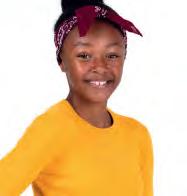






















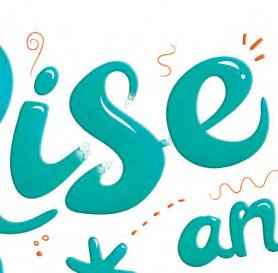
 Bella Leo Nadia Sam
Bella Leo Nadia Sam
5
Pearson Education Limited
KAO Two
KAO Park
Hockham Way Harlow, Essex CM17 9SR
England and Associated Companies throughout the world.
pearsonenglish.com
© Pearson Education Limited 2022
All rights reserved; no part of this publication may be reproduced, stored in a retrieval system, or transmitted in any form or by any means, electronic, mechanical, photocopying, recording, or otherwise without the prior written permission of the Publishers.
First published 2022
Set in Mark OT Pro Book (Student’s Book pages set in Daytona Pro Primary)
Acknowledgements
The publishers and authors would like to thank James Laidler (Educational Consultant) for his feedback during the development of the material and invaluable knowledge and guidance on the Managing inclusive classrooms section of the book.
The publisher would like to thank the following for their kind permission to reproduce their images:
Video screen shots
By ITN Productions
Course character artwork (including cover) Illustrated by BluBlu Studios
Student’s Book Acknowledgements
The publisher would like to thank the following for their kind permission to reproduce their photographs:
(Key: b-bottom c-centre l-left r-right t-top)
123RF.com: creativedoxfoto 27, grafner 28, Ian Allenden 61, Marco Rubino 73, margouillat 66, Michael Gray 56, yobro10 61; Alamy Stock Photo: Gary Dublanko 71, Greatstock 80, Jan Wlodarczyk 38, jay goebel 49, Jochen Tack 50, José Javier Ballester Legua 48, Josie Elias 78, Kike Calvo 70, Peter Titmuss 7, Ryhor Bruyeu 7, Simon Annable 91, Unnaugan 6, WENN Rights Ltd 34; Getty Images: ALAMA 28, AB Photography 17, alexsl 26, anatoliy_ gleb 56, bauhaus1000 6, Blablo101 78, Brainsil 8, braymar 7, CatBee 72, Christiantdk 39, Claudiovidri 38, Colleen Gara 18, damircudic 49, David Arky 40, Diana Robinson 12, Donald Iain Smith 89, Emma Tunbridge/Corbis/VCG 89, EVAfotografie 40, evemilla 40, Federico Veronesi 14, fizkes 26, 56, Focqus, LLC 7, FooTToo 19, fotoVoyager 67, Francesco Andaman Paglici/EyeEm 72, Günther Egger 48, Halfpoint 61, Hans Neleman 72, idildemir 7, Imgorthand 12, 61, ImpossiAble 50, Ingram Publishing 80, Jacky Parker Photography 74, Jan Hakan Dahlstrom 34, Jeremy Woodhouse 16, Jim Cumming 35, Jose Luis Pelaez Inc 60, kali9 90, Kike Calvo 70, kolotuschenko 75, LightFieldStudios 44, Maica 49, Marisa López Estivill 18, MASAHIRO_NOGUCHI_NY 92, Maskot 8, Mint Images 34, MIXA 12, monkeybusinessimages 79, 81, Nadydy 79, Nick David 81, Nicolas Vincent Photographe 35, NomadicImagery 38, Paolo_Toffanin 51, Pauline St. Denis/ Corbis/VCG 49, PeopleImages 50, Peter Mason 60, PHOTO 24 12,
PixelCatchers 70, PNC 66, Richard Drury 70, Richard Hutchings 88, Roi Shomer 35, Ruy Quinan/EyeEm 12, Sasi Ponchaisang/EyeEm 8, Sebastian Condrea 70, SergiyN 44, Sittipong Chananithitham 50, SolStock 44, SrdjanPav 56, sunstock 34, Suparerg Suksai/EyeEm 7, Taro Hama @ e-kamakura 51, Thinkstock 44, TriggerPhoto 7, urfinguss 34, Vadim Balakin 16, Yashwanth Pavanan/EyeEm 16, yoh4nn 74 Yukiko Nakashima / EyeEm 51; Pearson Education Ltd: Alice McBroom. Pearson Education Australia Pty Ltd 60, Jon Barlow 4, 5, 6, 7, 8, 10, 11, 12, 14, 15, 16, 20, 21, 22, 24, 25, 26, 32, 33, 34, 36, 37, 38, 42, 43, 44, 46, 47, 48, 54, 55, 56, 58, 59, 60, 64, 65, 66, 68, 69, 70, 76, 77, 94, 95, Jules Selmes 66; Shutterstock. com: 918485 29, Africa Studio 34, 34, anek.soowannaphoom 50, antoniodiaz 27, BlueOrange Studio 93, Bombaert Patrick 34, Bryant Aardema 17, Candid68 7, Chepko Danil Vitalevich 17, Christian Lehmann 18, clarst5 17, dantess 27, Evgeny Karandaev 49, filippo giuliani 38, goodluz 60, ID-VIDEO 66, JCStudio 51, Lopolo 44, Lutsina Tatiana 26, Mikbiz 66, Nik Niklz 18, one photo 12, Pearl PhotoPix 49, Peter Turner Photography 39, Philip Date 40, PhotoMagicWorld 47, Rob Wilson 66, Roman Arbuzov 27, Sergey Novikov 56, sirtravelalot 62, Soho A Studio 26, SpeedKingz 93, Svetlana Foote 17, tankist276 28, ted.ns 71, tetiana_u 66, TinnaPong 44, Travelerpix 66, v.s.anandhakrishna 56, Viacheslav Lopatin. 73
Cover Image: Front: Alamy Stock Photo: View Stock
All other images © Pearson Education
Illustrated by BluBlu Studios (course characters); Emma Allen/ Sylvie Poggio: p. 23; Elif Balta Parks/Advocate Art: pp. 45, 67; Fran and David Brylewski/Beehive Illustration: pp. 94-95; Lyn Dylan/ Sylvie Poggio: pp. 82-87; Denise Holmes/The Bright Agency: pp. 9 (Create), 19, 29, 39, 41, 51, 63, 73; Daniel Limon/Beehive Illustration: pp. 22, 33, 37, 50, 55, 62 (Ex 1); Hyphen SA (Zacharias Papadopoulos); Alejandro Mila/Sylvie Poggio: p. 9 (Review); Natalia Moore/Advocate Art: pp. 13, 35; Amanda Quartey/ The Bright Agency: pp. 57, 62 (Ex2); Kate Sheppard/Beehive Illustration: pp. 14, 24, 36, 46, 58, 68; Roger Simo/The Bright Agency: pp. 30, 52, 74.
www.un.org/sustainabledevelopment
The content of this publication has not been approved by the United Nations and does not reflect the views of the United Nations or its officials or Member States.
Dados Internacionais de Catalogação na Publicação (CIP) (Câmara Brasileira do Livro, SP, Brasil)
Rise & Shine in English : teacher's book : vol. 5 : PES grade 5. -- São Paulo : Pearson Education do Brasil, 2022. -- (Rise & Shine PES ; 5)
ISBN 978-65-5770-476-9
1. Inglês - Estudo e ensino I. Série.
22-103155 CDD-420.7
Índices para catálogo sistemático:
1. Inglês : Estudo e ensino 420.7
Eliete Marques da Silva - Bibliotecária - CRB-8/9380
Contents
Course overview
Scope and sequence 4

Introduction 6 Using Rise and Shine 8 Component overview 10 Course methodology
Skills development in Rise and Shine 12 Future skills 13 Unit walkthrough 15
Measuring progress in Rise and Shine 18
Practical tips and planning
Managing inclusive classrooms 21
Teaching with video 22
Facilitating speaking 23 Teaching with posters 24
Classroom management 25

Games and extensions 26
Classroom language 28
Course planning 29
Teaching notes and scripts
Teaching notes 30 Workbook 5 audio script 172
Scope and sequence
Vocabulary 1 Grammar 1Vocabulary 2Grammar 2
Welcome
A great place to live
Places: apartment, bridge, building, citycenter, City Hall, farm, fields, hills, street, village
1 Exploring wildlife
2 All about technology Review 1 Our lives (Units 1 and 2)
3 Sharing our skills
4
Animals: beetle, camel, cheetah, crocodile, deer, eagle, kangaroo, polar bear, tortoise, wolf
Technology: camera, cell phone, e-reader, game console, headphones, laptop, printer, screen, smart watch, speaker
What do you like doing? I like (talking to people).
What does he/she like doing? He/she likes (helping people).
A deer is (shorter) than a camel.
How often do you use a laptop? I (always) use a laptop.
Everyday items: bandage, diary, flashlight, helmet, key, magazine, money, puzzle, rope, snack
I have to/don’t have to (bring a rope).
Countries: Argentina, China, Italy, Mexico, Poland, Spain, Turkey, U.K., U.S.A.
What time do you wake up? I wake up at (five after/ to seven).
Adjectives: dangerous, friendly, important, intelligent, safe, young
Technology actions: post (an ad), print (pictures), turn off, turn on, upload (pictures), write (comments)

Camping objects: blanket, gloves, jacket, sled, sleeping bag, stove
Cheetahs are more (dangerous) than deer.
I (often) help. I’m helping now.
Does he/she have to (wear gloves)? Yes, he/she does. No, he/she doesn’t.
celebrate Review 2 Our world (Units 3 and 4)
Let’s
Festivals: balloons, band, candles, costumes, drums, fireworks, flags, lights, masks, parade
5 Being kind
Activities: care for a child, carry the groceries, clean the windows, clean up the trash, offer someone your seat, paint a fence, share food, visit someone, walk with friends, water the plants
6 Our important places Review 3 Our future (Units 5 and 6)
Goodbye
Celebrations
Vacation activities: buy a ticket, exchange money, go on a tour, go sightseeing, pack a suitcase, read a guidebook, stay in a hotel, take a taxi, travel by bus, wait in line
There was/wasn’t (a parade). There were some/weren’t any (fireworks).
Adjectives: dirty, frightened, hungry, surprised, thirsty, tired
I/You/We/They painted/didn’t paint the fence. He/She cleaned/ didn’t clean the windows.
He/She’s going to (travel by bus). We/They aren’t going to (exchange money).
Verbs: arrive, cry, laugh, pick up, smile, try
Where were you? When was (the party)? Who was (at the party)? Were you (tired)?
Did you (laugh)? What did she (need)? Where did he (walk)? When did they (arrive)?
Transportation: airport, bus, cable car, ferry, minibus, subway
What are you going to (do)? Where is he going to (stay)? When are we going to (go)? How are they going to (travel)?
Next year, it’s going to be bigger! It’s really exciting!
Mother Language Day: alphabet, Arabic, characters, Japanese, Spanish, Turkish International Day of Happiness: camping, circus, medals, rainbow, relatives, sunset World Children’s Day: chat, dream, enjoy, find out, join a club, learn International Day of Friendship: be kind, give, invite, meet, post, text
Course overview 4
PronunciationFunctional languageGlobal citizenship
Talking about ability
We can plant more trees and flowers.
apple /æ/, day /eɪ/
Expressing surprise Wow! Really? That’s unbelievable! How amazing!
Working together where we live
Real-world writing Project
A website A progress puzzle
foot /ʊ/, shoe /uː/
Giving advice and making suggestions
You should (talk to somebody). You shouldn’t (message people you don’t know).
climb /kl/, create /kr/
Making and responding to offers
May I help you? Thank you! That’s very kind.
Learning about animal habitats climate, habitat, shelter, survive
Using technology responsibly chat online, make video calls, open emails, search the internet
An animal fact sheet A wildlife space
A blog post A technology advice poster
clear /ɪr/, please /i:/
Asking for clarification and checking understanding
What does (baklava) mean? How do you spell (baklava)?
waited /ɪd/, smiled /d/, walked /t/
speaking /sp/, stadium /st/
Asking for and giving reasons
Why did she need help? She needed help because (her shopping was heavy).
Agreeing and disagreeing I agree. I disagree.
Sharing skills with others air, flat, float, sink
Celebrating different festivals moon, sky, stars, sun
Instructions A class skills share
A review An international festival display
Helping our communities collect, donate, project, volunteer
Learning about ecotourism accommodation, culture, ecotourism, souvenir
A story A kindness wall
An email A tourist brochure
Future skills
Future skills 1: Working with others
Future skills 2: Respecting others
Future skills 3: Presentation skills
Future skills 4: Organization
Future skills 5: Conflict resolution
Future skills 6: Making decisions
Course overview 5
Introduction


Rise and Shine is a six-level elementary course that develops language alongside global citizenship and future skills. Fun characters, relatable stories, and real-life videos support clear, child-friendly learning objectives that motivate students on their English-learning journey. Clear, structured lessons build to a final unit project and offer real opportunities to achieve, track, and measure progress, encouraging students to think about and take ownership of their own learning.
Rise and Shine provides a unique toolkit to support teachers in identifying and addressing the needs of every student. Clear, measurable outcomes that students can see and celebrate motivate them to engage with the new experience of language learning. Targeted support and achievable activities mean that every student has a chance to thrive and teachers can address challenges such as mixed ability and special educational needs.
Course principles























A sense of purpose
Rise and Shine has been designed with deliberate progress in mind. Every activity and lesson builds towards a clear objective and a final unit project that gives every student their Time to shine. Structured lessons support students in acquiring the knowledge, language, and tools they need as they work towards their Time to shine
A step-by-step approach
































Rise and Shine builds confidence in using English through a learning cycle of exposure, recognition, controlled practice, and freer practice. Each activity is designed to support students to build on what they have already learned and work towards a clear task at the end of each stage of the unit. The I can shine box consolidates the learning of each stage into an activity explicitly linked to the learning objective. This gives students the opportunity to pause and reflect on how confident they feel with the material in an age-appropriate way. These activities build to the final Time to shine task at the end of the unit, where students are supported through the steps to create and present a project of their own.
Clear progress and accessible learning outcomes








Each unit of Rise and Shine follows five stages, each comprising one or two lessons. The stages are clear to students and support them in understanding exactly how far they have come and where they are heading on their learning journey. This learning journey is signposted to students by colored progress paths in the Student’s Book.
Wonder activities that spark interest, draw on prior knowledge, and set out the quest for the unit
Imagine imaginative stories and activities that encourage cognitive engagement


Build meaningful language input and practice, providing direction and support, with a strong focus on building communication skills and confidence
Grow real-world content that opens students’ eyes through a global citizenship objective and provides opportunities to relate language back to their own lives

Shine a final unit project broken down into differentiated steps to allow every student to showcase their achievements
Rise and Shine is built on the Global Scale of English, which helps students understand exactly what they are learning and why. It is designed so that students are always aware of their learning goals for the unit and are able to chart their progress at the end of each stage of the unit through a clear I can shine activity.

Rise and Shine is also designed for use in inclusive and mixed-ability classrooms. It helps all students achieve their learning goals, while recognizing that this will look different for different students. Activities and lessons are structured to be increasingly challenging to allow all students to achieve.
Rise and Shine recognizes that teachers need their time to shine, too! Ideas to support and stretch individual students are offered in each lesson, alongside clear teaching notes divided by lesson stage. Each I can shine activity is supported by a framework of Achieve, Adjust, Exceed to empower teachers to assess progress at each stage of the unit.
Development of future skills and global citizenship English is more than just a school subject in the 21st century – it is a medium through which children learn about life and global and local issues that are relevant to them. Rise and Shine supports and guides students on their own learning journey through dedicated helpers in each stage of the unit. Just like the characters in their favorite adventure stories, students face exciting tasks that help them build a greater understanding of themselves and the world around them, all the while working towards clear learning goals.
6
Course overview 6 Think about animals that will visit your wildlife space. What habitats do they need? Write. 7 Share your ideas with your group. Choose animals and habitats for your wildlife space. 8 Design your wildlife space. Unit project A wildlife space I can talk about a wildlife space. 9 Present your wildlife space to the class. 10 What wildlife space could you have at school? 19 Wonder Build Imagine Grow Shine
Find a real wildlife space. Can you compare the animals you see? Don’t forget to name your wildlife space and use describing words! This is my wildlife space. You can see a pond with rocks and flowers. There’s a small house for birds.
to bees.
fox is bigger than the beetle. Our
Create Time to shine! M01_RS_SB5_AmE_99133_U01.indd 19 1/7/21 4:17 PM
Shine on!
There’s a bee hotel. It gives shelter
The
wildlife space
Welcome to the Great Places team








































Each level of Rise and Shine takes place in a different setting that is relatable to students but offers opportunities to explore. Level 5 takes place in and around the City Hall, where we meet the following main characters: Bella, Sam, Nadia, Leo, and Alex. Students will relate to the importance of the local community as the characters work together to complete projects in time for the Great Places Festival, where they hope to showcase everything the area where they live has to offer.


7
Course overview
Using Rise and Shine
Vocabulary and structures
Vocabulary in Rise and Shine has been carefully selected to be relevant to students and their lives and is presented in logical topic sets. Key vocabulary is always presented using the course characters or stories to provide students with a familiar context for the new language. Lesson 1 presents ten key vocabulary items, while an additional six key items are presented in Lesson 3. Vocabulary lessons always offer opportunities for students to reflect and share what they already know on the topic, before clear presentation and practice stages. The Workbook provides additional vocabulary practice. The Word connections pages at the end of the Workbook can be used to consolidate the vocabulary of each unit. In addition to the key vocabulary, four related vocabulary items are presented in Lesson 6 as part of global citizenship.
In Level 5, grammar structures are taught in simple chunks that students are able to grasp more easily than complex grammar rules. New structures are presented in a reading or listening context in Lessons 2 and 4. New language is clearly highlighted in boxes on the Student’s Book page that provide a reference point for students as they learn and practice. Grammar is further consolidated through a song in Lesson 4.
Every lesson includes opportunities for students to recycle language from previous lessons and units. New language is never presented in isolation but in the context of what students have already learned so that they are more likely to retain it.
Skills
Rise and Shine systematically develops the four skills through a stepped approach clearly defined in the lesson flow. Each skill is developed independently in the early part of the unit, before being brought together with an integrated skills approach in the Grow stage. Learning objectives covered in Rise and Shine have been specifically selected to help students at this level develop skills in a structured way. Special emphasis is put on communication, with a dedicated lesson in the Build stage to develop spoken communication skills and confidence. For more detailed information on how skills are developed in Rise and Shine, see page 12.
Global citizenship
A dedicated global citizenship lesson provides opportunities for students to explore the wider world by bringing realworld content into the classroom. Each unit has a different global citizenship focus that encourages students to think about global and local contexts, with emphasis on cultural awareness, empathy with local and global issues, and socialemotional skills development. For more information on global citizenship, see page 13.
Real-world links
Rise and Shine is story based and each level revolves around the community-based adventures of a set of characters. The stories and settings have been carefully chosen to be interesting and maybe slightly unusual to students, while still being firmly rooted in reality. The result is characters and stories that students can fully relate to but are exciting enough to capture and keep their attention. Real-world links are further reinforced through dedicated functional language lessons, beautiful pictures, global citizenship themes, and videos.
Projects
Every unit in Rise and Shine builds up to a final project that gives every student their Time to shine. As students move through the unit, they collect the language, knowledge, and skills they need to complete a final task that provides the opportunity for students to apply everything they have learned. Projects are broken down into achievable steps, so that every student can achieve at the appropriate level of challenge. For more information on projects, see page 20.
Inclusive classroom
Rise and Shine is especially developed to support every student to achieve. Assessment for Learning methodology and personalized activities support all students, with opportunities for extra support and stretch embedded into the lessons. Teachers are provided with clear guidance and targeted support in formative assessment activities, as well as tips and tricks throughout the course. For more information on managing inclusive classrooms, see page 21.
Assessment
Rise and Shine offers comprehensive in-course assessment to measure students’ mastery of the language and skills taught in the Student’s Books in relation to specific learning outcomes. A Diagnostic test helps teachers check previous learning and identify any areas for particular attention throughout the year. Dedicated activities in the Student’s Book provide opportunities for informal assessment at every stage of the unit, while Unit tests provide a more formal assessment of the unit objectives. Review lessons and cumulative Progress Review tests every two units enable teachers to check progress regularly against the key learning outcomes for the level. The final End-of-Level test offers a more formal evaluation of the year’s learning. For more detailed information on how to assess student performance, see pages 18 and 19.
8
Course overview
Motivation

Keeping young students motivated and on task in the classroom can be a challenge, especially in large and/or mixed-ability groups. Rise and Shine supports teachers by providing:
• a wide variety of purposeful activities so students never feel that they are doing the same activity types over and over,
• fun contexts that students can relate to,
• age-appropriate real-world content,

• stories, songs, games, and projects that provide plenty of fun,



• a lot of opportunities for students to communicate about themselves and their own lives,


• clear goals and opportunities for reflection with story character “helpers,”
• activities that build confidence and a sense of achievement for every student.

9
Course overview
Component overview






































For students

Student’s Book and Student’s eBook

The Student’s Book provides material to present and practice the key language effectively. It is divided into six core units, a Welcome unit, a Goodbye lesson, four Celebrations lessons, six Future skills lessons, and six Grammar lessons.
Workbook and Workbook eBook



































The Workbook provides reinforcement and consolidation of the language and skills presented in the Student’s Book. It contains practice for every lesson in the Student’s Book and a Word connections list to support students in reviewing and remembering key vocabulary. The Workbook is also available as a Workbook eBook.
wildlife






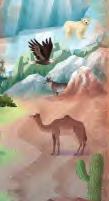













Busy Book
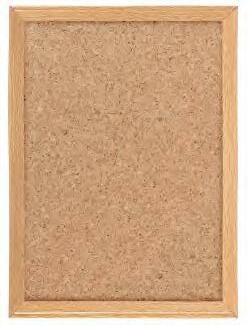
The Busy Book provides further practice of key language in a fun and engaging format. Activities are structured in such a way that students can work on them independently. It is a flexible component that can be used for whole-class work, in class for fast finishers, or at home.
Rise and Shine on the Pearson English Portal
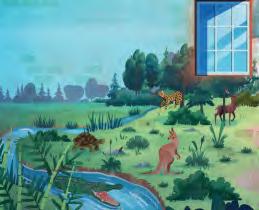
Students can access extra activities online on the Pearson English Portal. Here, they can complete assigned homework and check their progress, play extra games, listen to the course songs, and watch the course videos.


10
Our world My travel plans journal Explore with Alex 31 30 Find out. Then draw. What eco-friendly souvenirs can tourists buy in your country? Culture This hotel is cold: between -3°C and 5°C. A good sleeping bag is very important! You should also bring Accommodation Souvenirs If you’re going to stay in a tent, you must clean up. Plastic trash stays on earth for 500 years! You should One day I'm going to travel to Things to think about: • How am I going to travel? • Where am going to stay? • What places or festivals am going to visit? • What wildlife am going to see? • What skills am going to learn or use? Stick in pictures, draw and write. Do it yourself! My favorite activity in this unit: My favorite fact in this unit: This unit makes me feel because A bus tour is a good way to go sightseeing. You can learn a lot of interesting information about a city. Some festivals are older than you might think. The Venice Carnival started in 1162! Upcycled bags are good for the environment. Local food and drink make good souvenirs. There are many di erent cheeses to choose from in Spain! You’re the magazine writer! Finish the text.
Course overview 1 tortoise 2 crocodile 3 cheetah 4 kangaroo 5 deer 6 eagle 7 camel 8 wolf 9 polar bear 10 beetle Exploring wildlife 4 1 3 2 Lesson 1 What can you see? 1 Listen and explore. 2 1.02 Listen, point, and say. 3 Watch the video. 4 Where do the animals live? Say. Vocabulary Animals Structures A (deer) is (shorter) than a (camel). The wolf lives in the mountains. The crocodile lives in the river. 5 What animals live close to your home? I wonder Why are some animals in danger? 10 Name, describe, and compare animals. Understand a story about animal needs. Express surprise. Write an animal fact sheet. Design a wildlife space. 1 Look and write a e o, or u 4 Extra time? Order the animals from big to small. Compare with a partner.
Lesson 1 Vocabulary 2 Look at Activity 1 and write. 1 There’s a wolf in the mountains. 2 There’s a in the desert. 3 in the river. 4 sky. 5 snow. 6 2 7 3 8 4 9 5 10 d e e k ng r p r b b tl ch t h c m gl cr c d t rt w lf Let’s review! Write three animals that live in the ocean. Tell me! Which animals are on grass? I can shine! 9 7 8 6 Grammar A deer is shorter than a camel. A cheetah is bigger than a cat. A wolf is scarier than a tortoise. A kangaroo is cuter than a beetle. 5 Make riddles about animals. (shorter) than can compare two animals. Lesson 2 1 1.03 Read and write. Then listen and check. 1 It has a long tail and it can jump. It’s bigger than a monkey. What is it? 2 It’s bigger than a bee, but it’s smaller than an eagle. It lives in the grass. It’s very slow. What is it? 2 Read and learn. Wonder Imagine Build Grow Shine 3 Circle and say. 1 A beetle is bigger smaller than a tortoise. 2 A wolf is taller shorter than a camel. 3 A crocodile is cuter / scarier than a deer. 4 A tortoise is faster / slower than a cheetah. 4 Make sentences about the animals in the picture. The eagle is stronger than the deer. It’s faster than a camel, but it’s slower than a cheetah. It lives in the forest. What is it? 10 11 Lesson 2 Structures 1 1.04 Listen and check (✓). Then match to make sentences. 5 I can shine! 3 Choose your favorite animal. Write a riddle for a partner. Extra time? Make flashcards of new words. It’s It lives It’s than a It’s b d 1 A polar bear is bigger 2 A polar bear lives 3 A polar bear 4 A polar bear is 5 A wolf is smaller than a in the snow. b white. c a polar bear. d is bigger than a wolf. e than a tortoise. 2 Look choose, and write. 1 A tortoise is slower than a cheetah. (slow/fast) 2 A rabbit (tall/short) 3 A deer (cute/scary) 4 A polar bear (big/small) 5 A kangaroo (slow/fast)
Exploring
For teachers
Teacher’s Edition
The Teacher’s Edition supports teachers in planning and making sure students get the most out of Rise and Shine. It provides step-by-step lesson plans for every lesson, along with ideas for extra activities and games. It also provides a detailed introduction that outlines the methodology, as well as recommendations for effective use of all the course resources.
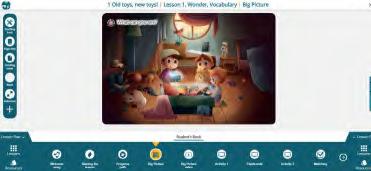
Workbook page reviews words students may already know which link to the vocabulary topic for this unit. This recycles wildlife dolphin, jellyfish, octopus, sea horse, seal, shark, starfish, whale
and
Rise and Shine on the Pearson English Portal Teacher’s Presentation Tool
The Teacher’s Presentation Tool offers teachers online lessons for presenting the material using an interactive whiteboard or projector. The lessons contain activities mirroring the sequence of material in the Student’s Book and the Teacher’s Edition, but in an interactive format best suited to a digital experience with integrated answers, audio, video, and classroom tools. The lessons also contain all the audio for the course. Teachers can navigate the material using the interactive lesson flow or traditional page view. The planning area gives a useful overview with both teacher’s notes and activity previews. The Teacher’s Presentation Tool is also available offline.
do the activity. Then invite pairs to share their ideas with the class. Ask students if they remember who the Wonder helper is (Bella). Have students think about all the different animals they know. Elicit different animals and write their ideas on the students to say which of those animals they can find close to where they live. To extend the activity, have students say which of them they can find in the country, but not necessarily close to where they live.
FUTURE SKILLS: enquiry and imagination Ask students what wild animals they have in their country and if they are in danger in any way. Ask what they can do to protect them. Ending the lesson Play Bingo with the class. Ask students to write six animals animals. the animal you say is on their list, they cross it off When all the animals have been crossed off they say Bingo! As you say each animal, raise its corresponding Picture Card to reinforce vocabulary learning.
Class audio





The class audio contains all the recordings for the Student’s Book and Workbook. All tracks are appropriately numbered on the pages of the Student’s Book and the Workbook. All audio for the series can be found in the teacher resources on the Pearson English Portal.
Assessment Pack
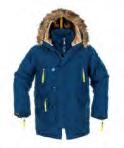






The Rise and Shine Assessment Pack contains everything needed for regular, formal assessment including a Diagnostic test, Unit tests, Progress Review tests, and an End-of-Level test. The Assessment Pack is available on the Pearson English Portal.


Picture Cards
There are 106 Picture Cards at Level 5, illustrating the vocabulary sets for each unit. The lesson plans offer ideas and support for using Picture Cards to present, practice, and consolidate language through games and activities.
Resources

The Pearson English Portal is an online location where teachers and students can find all the materials and tools that can be used inside and/or outside the classroom with Rise and Shine. Teachers can use it for lesson preparation, for delivering lessons, to assign and track homework, to monitor students’ performance, and to manage their classes. The resources available to teachers include: • assignable online homework with automatic grading, • a tool for tracking the performance of both individual students and the whole class, • an assessment pack, • all the audio and video for the course in one place, • digital versions of posters and Picture Cards, • extra resources, such as worksheets and games.
Posters
The posters designed for Rise and Shine are a great visual aid and can be used throughout the course. The posters include an introduction to the Level 5 characters and setting, vocabulary items, the Student’s Book Progress Chart, encouraging mindfulness and a growth mindset.
40 1 Exploring wildlife 2 4 I n describe, Understand Express surprise. Lesson 1 – Vocabulary Student’s Book page 10 Starting the lesson: warm up Ask students to name different animals that they know. Write them on the board. Ask a student to student describe the animal as best they can for the class to guess. Big Picture: What can you see? Look at the Big Picture and ask What animals Are they small? vocabulary set. Accept answers and ask them to point to the animals in their Student’s Book. write the phrases on the board and underline the adjectives, e.g., beautiful eagle a small white polar bear describe something. They are called adjectives and they go before the thing we are describing (the noun). picture and say what else they see in it, e.g., some big trees, some green grass. TEACHER TIME TO SHINE: recycling vocabulary good way of recycling vocabulary is to play the True/False game. Tell students to look at the (True) Students say if the sentences are true or false. Continue with more sentences. Draw students’ attention to the wonder question. Have students recall any animals they know that are in danger. Ask students why they think some Wonder Objectives where they live Target language: beetle camel cheetah crocodile deer eagle kangaroo polar bear Recycled language: There’s a can see It lives wild animals (e.g., lion snake tiger Productive: Speaking: Can describe where an animal lives in Receptive: Listening: Can identify animals from short descriptions. Wonder: sparking curiosity where wild animals usually live. Ask if wild animals should be taken out of their environment and placed in zoos or even kept as pets. Encourage students to explain their answers. Point to “Wonder” on the progress path and write the learning objective on the board: We’re learning to talk about where animals usually live. Audio; video; Picture Cards; sheets of Starting t Learning path t Big Picture t wonder t Presentation: Activity 1 t Presentation: Activity t Picture t 1 41 Listen and explore. Ask students what they think the conversation will be about. things they hear. SUPPORT Play the audio with pauses and have students say what they just heard. As a follow-up, ask likes cheetahs. Polar bears are Sam’s favorite animal.) Listen, point, and say. Teach the new vocabulary items with Picture Cards. Place them on the board and say each one as you point to it. Play the audio. Tell students to look at you. As the audio says an animal, point to its corresponding Picture Card. Tell students you will play the audio again for them to students to repeat. Watch the video. Explain to students they will now watch a video showing video, ask students to guess what animals they might see in the video. Play the video and elicit answers (birds, iguanas, seals, flamingos, penguins, tortoises, sharks). 4 Where do the animals live? Say. Place students in pairs and have them
too, they can compare answers together. Activity 1 Audio script Hey, Leo! Look at the artwork! It’s cool! Leo Wow! Is that a cheetah in the tree? Yes, is. There’s a deer hiding in the forest, too. Leo Yeah! And there’s crocodile in the river. Nadia Oh, yes! think the crocodile is scarier than the Leo There’s a wolf. Look at its gray fur. Nadia Yes, it’s strong. And there’s a beautiful eagle flying in the sky. It has big wings. Leo Oh, yes! And can see tortoise in the grass. a big white polar bear in the snow. Leo Wow! That’s my favorite animal. And is that Oh, yes! Oh, look what’s on my hand! Leo What’s that? Leo Oh, of course! There are beetles in our town and other animals, too. Like deer, butterflies, foxes, Workbook: t Ending t Extra activity t Our World video: Activity t Practice: Activity 4 t Wonder Helper t t Learning path Wonder Course overview 11 jacket Rise and FLC5 99027.indd 2/7/21
Look
write Students look at the ANSWER KEY: polar bear, cheetah, eagle, 5 tortoise, 6 kangaroo, 7 beetle, 8 camel, crocodile, 2 Look at Activity and write. Students look at the pictures in Activity to complete the sentences. ANSWER KEY: camel, There’s a crocodile There’s an eagle in the Wonder helper: Students look at the pictures again and answer the question. kangaroo Extra time: Students compare the animals by size and place them in order. They can write in their notebooks and another student has finished and done the activity,
Skills development in Rise and Shine
Support
Speaking Can describe someone’s physical appearance in a basic way, if guided by questions or prompts. (29)
Lowest within rangeHighest within rangeStretch
Can answer simple questions about habits and daily routines. (31)
The skills syllabus has been developed using the Global Scale of English (GSE) Learning Objectives and the GSE Skill Development Framework for Young Learners, which provides structured scaffolding to support teachers and students.
At Level 5, the GSE range covered is 31–39 as core, but includes learning objectives as high as 42 as stretch
The four skills are systematically developed within each level and across the course as a whole.
Reading: Tasks are designed to gradually increase proficiency in terms of speed, accuracy, comprehension, interactive reading skills, and use of reading strategies, as well as to enrich vocabulary. Texts gradually increase in length and complexity over the course so that the challenge is always appropriate to the level of the students. By the end of Level 5, students should have developed their early reading, decoding, and phonics skills introduced and practiced in Levels 1–4. They should comfortably identify the number of syllables in a word and recognize familiar words in unfamiliar contexts in stories and descriptive texts.
Writing: Writing skills are developed and coordinated with reading skills so that students are able to master both reading and writing in English. In level 5, students will be expected to work on their text complexity and on their text development strategies, with the highest expectation of writing to be writing a short text of 3–4 compound sentences, based on a model.
Speaking: Speaking skills are taught through a meaningful task-based approach. The course draws on a range of approaches to teaching speaking, in which students have plenty of opportunities to engage in communicative activities. The course provides a supportive framework for students to make the language their own. By the end of Level 5, students should be able to recall skills introduced and practiced throughout the level, e.g., answer simple questions, politely refuse simple requests, tell the time of day, role-play parts of a picture story. Students should also be working towards asking basic questions about a past event and introducing a new topic into a conversation or discussion.
Listening: In Level 5, listening sub-skills are systematically developed and linked to speaking outcomes. By the end of Level 5, students should be able to understand and make connections between words within the same area of meaning as well as recognize alternative words and expressions that can be used to convey similar meaning or effects.
Can give a short, basic description of a special event if guided by questions or prompts. (39)







Can answer simple questions after giving a presentation on a school topic. (42)
Within the four language skills, the sets of learning objectives are grouped into strands relating to accuracy and appropriacy, complexity and organization, interaction and strategies. Within these strands, the objectives are further grouped into specific areas of competency and then further aligned to key development indicators. See example: Speaking
GSE Learning Objective: Can give a short, basic description of a special event if guided by questions or prompts. (39)



Competency: Building Complexity – talking about and describing a range of topics, situations, feelings, and attitudes with an increasing level of detail and complexity.
Development Indicator: Learners can use simple language to talk about and describe familiar objects and situations or express basic opinions or attitudes in short stretches of speech.

The development indicators capture each discrete skill that students are aiming to acquire. Breaking the skills down in this way supports the development of related skills that build on one another and are at the right level, giving students the best chance to learn and achieve.
The skill coverage charts on the Pearson English Portal show the key skills covered across the course and the learning objectives in each level that relate to these. By monitoring student performance on the tasks relating to these objectives, teachers can see how students are progressing within and across levels and where they may need more opportunity to practice, so they can build this into their planning. Note that lessons are based on individual learning objectives, but student progress is measured in terms of their performance on the key indicators selected for the course.
The Student’s Progress Chart enables students to think about and document their progress in an age-appropriate way as they move along the learning journey. Teachers can also use the chart as a clear visual reference to showcase students’ learning and progress to parents.
12
3 can understand important details in short conversations. can recognize familiar phrases in conversations. I can follow a conversation and the events in a story. I can understand conversations about past events and future plans. Listening can understand key information in short texts. can understand the sequence of events in stories. I can understand the gist and overall themes of texts. I can recognize different text types and their features. can ask for and give information about my community. can participate in social exchanges. I can make and respond to offers, suggestions, and requests for information. I can ask and answer questions about past events and future plans. can write sentences to describe pictures. can link simple sentences and add detail to my writing. I can write short texts on familiar topics. I can use the correct phrases for different text types. Reading Speaking Writing My Progress Chart Welcome Unit 2 Unit 1Unit 6 Unit 5 Unit 4 Unit 3 F01_RS_SB5_AmE_99133.indd 1/7/21 4:07 PM Course methodology
Every unit in the Teacher’s Edition starts with a unit overview of the key areas covered in the unit. As well as highlighting target language for the unit, it also acts as an at-a-glance guide to the unit objectives and key progress indicators.

Future skills are general and transferable skills that contribute to how someone functions in the world, both individually and with others, and are sometimes known as “soft skills.” These are personal and social skills that students will need to become responsible citizens and include well-known skills such as collaboration, communication, critical thinking, creativity, social responsibility, self-management, and leadership. Future skills are embedded in the course activities and modeled by the course characters throughout. Clearly signposted sections in the teaching notes provide extra support to teachers through tips and ideas to further enhance future skills learning and practice. The Future skills section in the Student’s Book enables students to learn about and develop specific skills, with detailed teachers’ notes available on the Pearson English Portal to support the delivery of these lessons. Individual skills are developed systematically in the following ways.
Enquiry and imagination

The Global Scale of English (GSE) is a standardized, granular scale that measures English language proficiency. Unlike some other frameworks that describe attainment in broad bands, the GSE identifies what a learner can do at each point on a 10–90 scale across speaking, listening, reading, and writing skills. The scale is designed to motivate learners by giving more granular insight into learning progress. Teachers can use the GSE level to match a student to the right course materials for their exact level and learning goals.
The badging on the back of the Student’s Book indicates the GSE proficiency range from which the learning objectives for that course level have been selected. A course will not cover all learning objectives from that range – just a representative selection that is appropriate to the target learners. Knowing this range helps you select additional materials with the right level of support and challenge for your students to help them progress. It does not mean that students need to have mastered all objectives below the range before starting the course, or that they will all be at the top of the range by the end.




The Global Scale of English framework contains learning objectives for all four skills for language learners in four different domains: Young Learners, Adult Learners, Academic Learners, and Professional Learners. The objectives in each set have been rated by experts and teachers in each of those domains from around the world for their relevance and level of difficulty for learners in that context.
To see full sets of the objectives and for more information about using the GSE to support teaching and assessment of your learners, please go to www.english.com/gse.
In all levels of Rise and Shine, students are provided with opportunities to be creative and use their imaginations, through stories, activities, and projects. In lower levels, creative thinking skills are facilitated through activities that promote new and original ideas and help students express themselves. Students may be asked to evaluate ideas and communicate new ideas to others. At higher levels, students are encouraged to use mind maps.
Critical and reflective thinking

Activities in Rise and Shine have been developed to provide a level of cognitive challenge in line with students’ age. As they move through the course, students are asked to engage with the language using lower-and higher-order thinking skills, as appropriate. There are constant opportunities for information processing, using skills such as following instructions, locating and collecting information, classifying, and sequencing ideas, which contribute to students’ ability to retain and confidently use the key language. Rise and Shine also provides students with consistent opportunities for self-assessment and reflection.
Collaboration and communication

Rise and Shine offers a unit structure that encourages students to work together towards a shared goal. Individual and pairwork activities develop throughout the course from short answers and dialogs to group work and team projects. As communication and collaboration are integrated with other skills, a holistic approach is encouraged and promoted from the outset to encourage shared participation and responsibility to find answers with valued individual contributions.
Social responsibility and global citizenship







Social responsibility is all about encouraging students to take responsibility for their behavior in the world and to behave with sensitivity toward social, cultural, civic, and environmental issues. Rise and Shine encourages this through a strong global citizenship syllabus that invites students to take an active role in their community and collaborate to make the world more equal, fair, and sustainable. It fosters the belief that every student can make a difference.

13
Global Citizen Let’s be friends Let’s be friends Global Citizen Let’s be friends Let’s be friends
Citizen share toys! I share toys! Global Citizen share toys! I share toys! Global Citizen celebrate all families! I celebrate all families! Global Citizen I celebrate all families! I celebrate all families! Global Citiz I play with friends! I play with friends! Global Citiz play with friends! I play with friends! OptA OptB OptC OptD Lorem ipsum 30 in Welcome, the students will: Key learning outcomes Understand overall meaning and main idea(s) from short sentences and texts on everyday topics Participate in social exchanges in English Understand overall meaning and main idea(s) from short sentences and texts on everyday topics Create a progress puzzle Exchange information on familiar topics A great place to live Welcome Wonder Imagine Build Grow Shine 31 Target vocabulary apartment bridge building city center City Hall fields village Countries: Argentina China Italy Mexico Poland Spain Turkey Recycling and building like going to the city. It’s one o’clock/one-thirty. Language stretch Functional language We can plant more trees and flowers. Values Working together where we live. Competency focus Be motivated to learn and recognize the different strategies to approach and complete tasks. Unit overview Key progress indicator chart Target structures What do you like doing? like (talking to people). What does he/she like doing? He/She likes (helping people). What time do you wake up? wake up at (five after/to seven). GSE range for Level 5: 31–39 (stretch 42) Development indicator: Speaking Ask and answer questions about past events and future plans. Working towards: taking part in conversation of exchanges, using range of tenses and descriptive language and, at the highest level, being able to present on a topic of interest and engaging with an audience. Can take part in a very simple conversation on a familiar topic (e.g., their home, family, school) if the other speaker repeats questions as necessary and speaks slowly and clearly. (32) Participate appropriately in common social and interpersonal exchanges using simple language and expressions. Can tell the time of day to within ten minutes. (32)Use a few words to name, talk about, or describe familiar Can talk about familiar place in a basic way. (35) Use simple language to talk about and describe familiar objects and situations or express basic opinions or attitudes in short stretches of speech. Writing Use the correct phrases for different text types. Working towards: writing 3–4 compound sentences in a structured paragraph on familiar topics and, at the highest level, being able to write for a range of informal and formal purposes. Can understand a simple written dialog on a familiar topic. (32) Understand overall meaning and main idea(s) of simple written texts on everyday topics. Future skills Course methodology
Global
Rise and Shine puts particular emphasis on cultural awareness, empathy with local and global issues, and social-emotional skills development. Context and content in the Imagine and Shine stages support the development of responsible global citizens, while the Grow stage provides the opportunity for students to consider the wider world. Activities use the global context to encourage students to think about both local and global relevance.
Future skills helpers
The Rise and Shine unit stages link to future skills and each stage has a dedicated “helper” who guides and supports students in activities that develop these skills.
The Wonder helper Bella sparks students’ interest and enquiry with a personalized question.

• Enquiry
• Critical and reflective thinking The Imagine helper Sam engages students with the story and encourages them to think imaginatively, creatively, or critically.
• Imagination
• Critical and reflective thinking
The Build helper Nadia promotes confidence and self-management, and encourages communication and collaboration by leading a motivating activity.

• Communication
• Self-management and leadership
The Grow helper Alex asks questions that encourage children to draw comparisons between the lesson content and their own lives, and to think as global citizens.

• Critical and reflective thinking




• Social responsibility
Self-management and leadership
Self-management enables students to organize their work and progress through skills such as organization, planning, persistence, and attention to detail. Activities in Rise and Shine are carefully staged and more complex activities, such as writing and projects, are presented in clear steps to support students as they learn to plan and organize their time. Students are also actively encouraged to develop their leadership skills through activities that enable problemsolving, teamwork, presenting, and assessment of students’ own progress and learning.

Rise and Shine promotes persistence and a growth mindset in the classroom, which helps students view ability as something that is changeable rather than fixed. Activities encourage students to relish challenges, embrace their mistakes as part of the learning process, value the importance of effort, respond carefully to feedback, and take inspiration from others. This will help them achieve, not only in the English classroom, but also in their future lives as adults.
The Teacher’s Edition offers teachers extra support by explaining how images, stories, and activities spark curiosity, foster imagination and creative thinking, build confidence, nurture growth, and allow students to shine.
Rise and Shine and the UN Sustainable Development Goals
In 2015, all UN Member States adopted 17 Goals as part of the 2030 Agenda for Sustainable Development – a global call to action to protect the planet, end poverty, and improve the lives of all the people.
In Rise and Shine, the overarching unit topics have been developed with reference to the UN Sustainable Development Goals. The content and context for the stories support in developing responsible global citizens. The Grow lessons, in particular, provide the opportunity to expose students to the wider world and use the global context as a springboard for thinking about both the local relevance and bigger picture ideas. The end-of-unit project is a vehicle through which students can explore wider global citizenship themes and some of the UN Sustainable Development Goals, such as:
SDG 3: Good Health and Well-being (using technology responsibly; Unit 2)

SDG 10: Reduced Inequalities (sharing skills and teaching others; Unit 3)
SDG 11: Sustainable Cities and Communities (helping people and celebrating our communities; Units 4 and 5)


SDG 12: Responsible Consumption and Production (encouraging responsible tourism; Unit 6)

SDG 13: Climate Action (respecting and caring for animals and the environment; Unit 1)

SDG 16: Peace, Justice, and Strong Institutions (peace and kindness starts with us; Unit 5)

For more information on the UN Goals, please visit https://www.un.org/sustainabledevelopment/

14 Course methodology
Unit title: sets out the quest for the unit and the project end goal.















































Progress path: sets out the learner journey and reaffirms the stage the students are on.
can shine!

I wonder question: engages students with the unit topic and sparks curiosity. Students find out the answer to the question in the unit.
Lesson 1

Wonder stage: activities to spark curiosity.
• Presentation and practice of vocabulary with audio support. Previous knowledge of the topic is activated through an Assessment for Learning activity.

• Students listen to the key unit vocabulary in the context of a dialog between the characters.
• Target vocabulary is included in the engaging and highly illustrated Big Picture.

• Our world video, with real-life footage, promotes learning in context.
• The Pearson English Portal offers students of all levels further practice to help reinforce the learning objectives and consolidate their learning.



• The Workbook Word connections list helps students to review vocabulary.

Digital: Picture Card presentation, Our World video, extra vocabulary practice




Lesson 2
• Presentation and practice of grammar. New structures are presented through a reading and/or listening activity and then consolidated.
• Clear and concise learning objectives help clarify the aim of the lesson for the teacher and parent.
I can shine at the end of the lesson practices the language and structures in a communicative speaking task.
Digital: Grammar presentation and additional grammar practice






































Further practice of the target language is provided in the Workbook for all lessons. Lesson 9 provides students with an opportunity to consolidate and personalize their learning through the journal activity.

15 Course methodology Unit walkthrough 1 tortoise 2 crocodile 3 cheetah 4 kangaroo 5 deer 6 eagle 7 camel 8 wolf 9 polar bear 10 beetle Exploring
4 1 3 2 Lesson 1 What can you see? 1 1.01 Listen and explore. 2 1.02 Listen, point, and say. 3 Watch the video. 4 Where do the animals live? Say. Vocabulary Animals Structures A (deer) is (shorter) than a (camel). The wolf lives in the mountains. The crocodile lives in the river. 5 What animals live close to your home? I wonder… Why are some animals in danger? 10 Name, describe, and compare animals. Understand a story about animal needs. Express surprise. Write an animal fact sheet. Design a wildlife space. M01_RS_SB5_AmE_99133_U01.indd 10 1/7/21 4:16 PM I
9 7 8 6 Grammar A deer is shorter than a camel. A cheetah is bigger
cat. A wolf is scarier
A
is cuter
beetle. 5 Make riddles
Structures (deer) is
than a I can compare two animals. Lesson 2 1 1.03 Read and write. Then listen and check. 1 It has a long tail and it can jump. It’s bigger
What
2 It’s bigger
bee, but it’s smaller than an eagle. It lives in the grass. It’s very slow. What is it? 2 Read and learn. Wonder Imagine Build Grow Shine 3 Circle and say. 1 A beetle is bigger / smaller than a tortoise. 2 A wolf is taller / shorter than a camel. 3 A crocodile is cuter / scarier than a deer. 4 A tortoise is faster / slower than a cheetah. Make sentences about the animals in the picture. The eagle is stronger than the deer. It’s faster than a
10 11 M01_RS_SB5_AmE_99133_U01.indd 11 1/7/21 4:16 PM
wildlife
than a
than a tortoise.
kangaroo
than a
about animals.
(shorter)
than a monkey.
is it?
than a
camel, but it’s slower than a cheetah. It lives in the forest. What is it?
Lesson 8 Unit 1 Review 1 Read and complete the crossword. 1t o r 4 t 6 o s 7 e 2 1.19 Look and write. Then listen and check. 1 young The cheetah is younger than the wolf. 2 slow 3 dangerous 4 colorful 10 Across 2 This animal lives in family groups. It lives in the mountains. 6 This animal is dangerous. It lives in rivers. 7 This animal is a big bird. It can fly high. Down 1 This animal is slow. It lives in grasslands or in the desert. 3 This animal can run very fast. It’s yellow with spots. 4 This is a small insect. It’s sometimes black and shiny. 5 This animal is white. It lives in the Arctic. 6 This animal is big. It lives in the desert. 3 Read and write. Then change the words in blue and role-play. Extra time? I live in grasslands. I’m bigger than a tortoise. I jump on two legs. What am I? Really ? (lyeral) Good job! That’s (banluieevbel) (oww) How (znamiga) I’ve finished my homework, Dad I can stand on one leg for ten minutes. My grandma is eighty today! Look over there. It’s a deer 2 3 4 M01_RS_WB5_8846_M01.indd 10 2/7/21 10:56 AM 11 Home-school link Tell your family about your favorite animals. Lesson 9 Time to shine! 1 Think and complete. Then add another animal to each habitat. Which animal lives in all three habitats? 2 Complete your journal. Step 1: Choose two animals. Step 2: Write your journal. Step 3: Find or draw pictures to decorate it. Unit 1 An amazing animal: A difficult word: An interesting fact: Tip! Keep a dictionary of difficult words. grasslands forest desert cheetah 3 Think and write. The same Camels and desert tortoises live in desert habitats. Camels and desert tortoises eat plants. Different Camels are more dangerous than desert tortoises. Camels have bigger feet than tortoises. cheetah eagle tortoise wolf deer kangaroo camel beetle desert tortoises Camels VS like camels and desert tortoises, but my favorite animal is the camel! The camel M01_RS_WB5_8846_M01.indd 11 2/7/21 10:57 AM
Lesson 3

Imagine stage: stories and activities to encourage cognitive engagement.









• A pre-reading activity that uses simple reading strategies and a vocabulary review.
• The story develops reading skills and strategies as well as presenting new target vocabulary.
• Activities to consolidate understanding of new vocabulary and reading comprehension.
• The I can shine task enables further development of reading skills appropriate for the level and the opportunity to personalize the text.




• The Workbook Word connections list helps students to review vocabulary.
Digital: Picture Card presentation, extra vocabulary practice, additional pre-reading support


Lesson 4
Build stage: meaningful language input and activities with a strong focus on building communication skills and confidence.
• Presentation of Grammar 2, contextualized through listening and reading, with further vocabulary practice.

• Clear presentation of Grammar 2 with a controlled practice activity, led by the Build helper, Nadia.
• An engaging song to provide further practice and consolidation of new grammar.
• Personalized practice of the grammar within a meaningful context.
Digital: additional grammar practice; karaoke song















Lesson 5
• A clear, character-led presentation of key functional language in a relevant context.
A young girl lives close to the forest with her grandmother. “We need wood for the fire,” says the old woman. “I’m stronger than you, Grandma,” says the girl. “I can go to the forest.”


“Be careful,” says her grandmother, “There are dangerous animals.”




















In the forest, the girl starts to cut down a tree. Some colorful parrots fly out. “Go away!” they call.

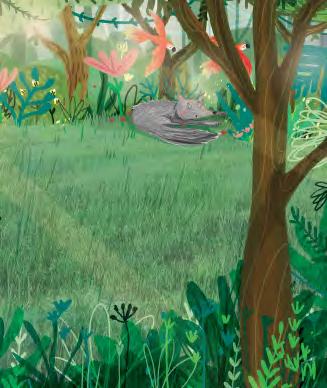

She sees three monkeys in the tree. “Those animals are safe here,” she thinks. “This is their home.”
Then a friendly deer comes from behind the tree. It’s eating some leaves. The girl sees a bee. It’s working in the flowers. Suddenly, a wolf wakes up under the tree. The wolf is more dangerous than the deer.



“Help!” says the girl. She runs away, but the wolf is faster than her. “Stop!” calls the wolf. “I want to talk to you.”











The girl is surprised.
“Listen!” says the wolf. “Trees are important They’re our homes and our food. They give us oxygen.You’re an intelligent person! Take some wood but don’t cut down our trees.”
The girl takes some wood for the fire and goes home. “You’re safe!” says her grandmother. “Yes, Grandma,” says the girl. “But the animals aren’t safe. We should plant more trees. The animals need their homes and we can share the forest with them.”
going to be on TV!
• A pairwork activity that provides the opportunity for students to repeat the speaking model followed by controlled practice.
• A light pronunciation strand that pulls out sounds from the language in the unit.
































• Communication Cards that are tied to a GSE speaking skills Learning Objectives.

Digital: extended pronunciation presentation and practice, Communication Cards

































































































16 Read and learn. Then write and say. Lesson 4 Communication Expressing surprise. 1 Read, listen, and write. Why does Joe like cheetahs? My favorite animals are deer. I think cheetahs are better than deer. Really? Why? Look. The cheetah is more beautiful than the deer. I think cheetahs are more dangerous than deer! 4 Ask and answer. Use the prompts. school subjects hobbies sports places pets Read and sing. What is the song about? Cheetahs are faster than rivers,
An eagle/intelligent/a beetle. Polar bears/dangerous/deer. Cheetahs/colorful/wolves. A kangaroo/interesting/a camel. the deer. deer. than than more beautiful more dangerous sunny days. worse than is are are movies. better than are Do you think math is more interesting than English? No, I don’t. I think English is more interesting than math. Remember! Good better Bad worse I can express surprise. Match. Then say with a partner. Guess what? I’m going to be… It’s my birthday. I have… My grandpa is very old. He’s… We’re going on vacation to… 1 1.09 Read, listen, and write. What is Bella making? She’s Lesson 5 2 1.10 Listen again and repeat the words in blue. 15 I can shine! 5 Talk with a partner. Express surprise. Wonder Imagine Grow Shine Build Sam: What are you doing? Bella: I’m making a hotel for bees to live in. Sam: Wow! I like bees. Bella: Me, too. They’re intelligent. They dance to tell other bees where food is. Sam: Really? Bella: Yes! They visit 50 to 100 flowers to make one teaspoon of honey. Sam: That’s unbelievable! Bella: I know! And bees are the only insects that make food for us. Sam: How amazing! Bella: That’s why I’m making a bee hotel! Say and write. Then listen and check. amazing can and that way make a 75. b touch my ear with my foot. c on TV! d Spain. e a new bike. Camels can live for three months with no food or water. That’s unbelievable! I can understand events in a story. I can shine! 5 Imagine another animal in the story. Answer. What does the girl see? What’s the animal doing? What does the animal say? What does the girl think? 12 Vocabulary Adjectives Story value Protecting the places where animals live. 1 Look. How many different animals are in the story? 2 1.05 Read, listen, and write. What does the girl learn from the animals? 3 Match the words in the text to the pictures. Lesson 3 1 4 2 5 3 6 4 Read again. Then circle. 1 Grandma says, “There are kind / dangerous animals.” 2 A young / old girl goes into the forest. 3 The tree is a safe / dangerous home for parrots and monkeys. 4 A friendly / scary deer eats leaves from a tree. 5 The girl runs away from a fast / slow wolf. 6 The wolf says the girl is intelligent / important What do animals need? M01_RS_SB5_AmE_99133_U01.indd 12 1/7/21 4:16 PM 13 Protecting Imagine Wonder Build Grow Shine
Grammar builder
Sharing the forest
Course methodology
M01_RS_SB5_AmE_99133_U01.indd 13 1/7/21 4:16 PM
Joe: Akanni: Joe: Akanni:
Lesson 6
Grow stage: activities to see real-world content that opens students’ eyes through a global citizenship strand.
• Real-world reading text.

































































• Four new vocabulary items are presented within the text that tie in closely with the unit topic.



• Comprehension with critical thinking.
• A listening task that extends the topic explored in the lesson and develops listening skills appropriate for the level.
• Alex, the Grow helper, asks a question that encourages children to draw comparisons between the lesson content and their own lives.

Lesson 7
Animals in danger












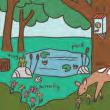
• The model writing text relates the global citizenship strand to a real-world and functional context known to students.
• An Ideas generator activity that helps students personalize the context further and provide further ideas for their own writing.

























































• A Give it a go activity that provides step-by-step planning, reflective of the model text, to support students in structuring their writing.
• Students produce their own version of the text genre/realia in the I can shine activity, simultaneously practicing the vocabulary and grammar structures learned in the unit.
Lesson 8

Shine stage: activities stepped out to allow all students to showcase their achievements and feel a sense of pride.
• Students “reimagine” what they have learned in their own context in answer to the unit title.




















Step 1: Review and personalization through differentiated “steps” allows all students to showcase achievements and feel a real sense of pride.
• Recycles and reviews language input from the unit and provides controlled speaking practice.






Digital: Our World video





























































Lesson 9
Step 2: Students think and create.
Time to shine: Students share their project with the class, encouraging communication and collaboration.
Shine on: An extension activity that allows students to extend their projects further and make additional connections to the wider world.






























































17 Unit project A wildlife space M01_RS_SB5_AmE_99133_U01.indd 18 Think about animals that will visit your wildlife space. What habitats do they need? Write. Share your ideas with your group. Choose animals and habitats for your wildlife space. Design your wildlife space. A Present your wildlife space 10 What wildlife space could you have at school? 19 Wonder Build Imagine Grow Shine Shine on! Find a real wildlife space. Can you compare the animals you see? Don’t forget to name your wildlife space and use describing words! This is my wildlife space. You can see a pond with rocks and flowers. There’s a small house for birds. There’s a bee hotel. It gives shelter to bees. The fox is bigger than the beetle. Our wildlife space Create 4 1.14 Listen. How do desert tortoises survive? 5 1.15 Listen again. Then circle. 1 Desert tortoises are smaller / stronger than some other tortoises. 2 They can / can’t run fast. 3 Desert tortoises eat desertplants / animals 4 Desert tortoises can survive without water for one year / 50 years Read again. Then answer. 1 What’s the weather like in the Arctic? 2 How do cheetahs survive in grasslands? Why are some animals moving into cities? Global Citizenship Animal habitats around the world An animal fact sheet 1 Look. What do you think the text is about? 2 1.13 Read and listen. Which animals are in the text? How can we help wild animals in our cities? Animal habitats Animals live in different habitats around the world. All animals need food and shelter. But some habitats are dangerous for animals. How do they survive? Arctic habitats The Arctic has a cold and windy climate, with a lot of snow and ice. Polar bears can live there because they have thick fur to keep them warm. You can’t see polar bears because they’re white, like the snow. This is how they stay safe. There are no trees or plants in the Arctic, but polar bears eat fish. There are a lot of fish in the Arctic habitat with cold climate Gob l C tiz n Glob C ien Gob C tz n Glob C en Gob C tiz n Glob C Gob C tiz n play with Gob C z n try different Gob C tiz n OptA OptB OptC OptD Lorem ipsum Global Citizen Learning about animal habitats.
But some animal habitats are changing. In the Arctic, the ice is getting smaller. This is a problem for animals like polar bears. In other places, people are cutting down trees in the forests and building houses where wild animals live. Wolves, deer, tigers, and crocodiles are coming into cities. They’re looking for food and shelter. Many animals need our help to survive in the future. Grassland habitats Grasslands in Africa have a hot climate. Cheetahs survive because they can run very fast to catch animals to eat. They have spots on their fur, too, so that they’re difficult to see in their habitat. When cheetahs need a shelter to sleep, they usually climb a tree. A shelter in a tree Lesson 6 Lesson 7 1.18 Plan your animal 17 shine! I can write an animal fact sheet. Write your animal fact sheet. sheet Choose an animal, bird, or insect. Describe the animal. Compare it to another animal. Where does it live? What does it eat? Wonder Build Imagine Shine Grow WILDLIFE TRAIL Eagles live in and mountains. 1 1.17 Read and listen. Where can you find the animals? 2 Read again. Find words to describe the animals. Which animals can youfind? Fact sheet: Ladybugs Ladybugs are small beetles. They have two beautiful red wings with black spots. Ladybugs are more colorful than many other beetles. They live in the grass and on flowers close to the pond. They eat small insects. Fact sheet: Frogs Frogs are small and green, with two big eyes, a big mouth, and strong back legs. They’re bigger than ladybugs. They live in water and close to the pond. They eat insects and small animals.
Our writing workshop
Course methodology
deas generator Listen and write. Give it a go fact sheet. they can fly. Deer eat ocean! small I
Measuring progress in Rise and Shine
In Rise and Shine, students engage in a variety of contextualized activities, each of which focuses on a particular Global Scale of English (GSE) learning objective. These objectives are fully supported by the Rise and Shine Assessment Pack. However, fair and accurate assessment in a language classroom reflects not only what students can recognize and produce in a test, but also what they can perform or do as they actually use the language in real or realistic contexts. To evaluate students’ progress fairly and fully, both of these aspects must be part of an effective approach to assessment.
Assessment Pack
The Rise and Shine Assessment Pack is a useful evaluation tool with a wealth of activity types to support teachers in assessing the students’ language skills. In this pack, teachers can find four kinds of ready-made tests that will help them form an accurate evaluation of their students’ understanding and achievement. The Assessment Pack is available on the Pearson English Portal.
Diagnostic tests are designed to help evaluate students’ current language ability in English against the learning outcomes of the course. This should be given at the start of each new level and will help provide a picture of students’ existing knowledge. It also provides awareness for teachers of where individual students or the whole class may need support as they work through the course. The tests should be administered in a relaxed and supportive atmosphere.
Unit tests correspond to the content material in each of the units and reflect the learning objectives of the unit. These tests provide a useful snapshot of student achievement at the end of a unit and also provide feedback to teachers and students on the progress made against the unit learning objectives. The tests can help identify any areas where further support is needed for individuals or the whole class. The test results can also help teachers adjust plans for the next unit and any further practice.
Progress Review tests serve as checkpoints throughout the year to provide teachers with a way of checking progress towards key learning outcomes for the level, based on students’ performance on activities aligned to the key competency indicators. As with the Unit tests, information gained from these should be used to identify areas where students may need additional practice or support. Progress Review tests additionally reassess student understanding and retention of the language and concepts taught in the previous units. This repeated practice helps students remember and integrate material learned over time and support teachers in making decisions regarding which language points and skills need further review.
The End-of-Level test provides teachers with a tool to assess progress against all of the key competency indicators for the level and to assess class readiness for the next level. It helps teachers evaluate the level of students individually and as a whole class, and supports decision making and planning for the next level.

Diagnostic, Progress Review, and End-of-Level tests focus on objectives relating to the key learning outcomes for the level in order to provide teachers with a clear, measurable way to track students’ progress towards these over the course of the year. The Progress Review and End-of-Level tests are cumulative in order to provide a clear picture of the progress students are making. The Unit tests are focused on the learning objectives of the specific unit and are not cumulative.
Each test has A and B versions available. These versions assess the same learning objectives and language at the same level and are provided for simultaneous use to provide variety in large classes. Each test also has a C version to enable students who require extra support to achieve a similar minimum standard as the rest of the class. Unit and Progress Review tests also have a D extension to provide additional challenge to students who may have mastered the content more quickly than the rest of the class.
The Assessment Pack also includes access to a test generator, which teachers can use to create and tailor tests for specific needs and situations.
English Benchmark Young Learners is a motivating English test for young learners aged 6–14, which can be used to understand students’ English abilities, identify their learning needs to ensure teaching targets the right skills, monitor, and demonstrate progress to parents. English Benchmark measures students’ speaking, listening, reading, and writing skills through fun and interactive tablet-based activities, with immediate detailed reports for teachers and parents that include students’ strengths, suggestions for improvement, and recommended activities to improve their skills. As students learn with Rise and Shine, English Benchmark tests can be used to measure their progress. After students have taken their test, recommendations are available on areas to focus on to support improvement.
In Rise and Shine, the Level 1 End-of-Level test includes key skills and activity types covered in English Benchmark in order to prepare students to take the test the following year, at the end of Level 2. From Level 2 onwards, it is advised that students take English Benchmark Young Learners test once per academic year, at the end of each completed level of the course. For more information, visit pearsonenglish.com/ benchmark.

18
Course methodology
English Benchmark Young Learners
Assessment for Learning
Rise and Shine includes Assessment for Learning methodology, which supports students along their learning pathway. This methodology is embedded within every lesson across every unit in each level of the course. Assessment for Learning methodology provides a clear and easy-to-use framework that enables students to take responsibility for their learning and teachers to support the learning progression of each student in their class.
What is Assessment for Learning?
Assessment for Learning is more than testing. It involves an ongoing engagement with students, so that what they know now helps inform what they learn next. A balanced approach to assessment includes frequent informal prompts, games, and other activities that allow students to understand where they are and identify gaps in their understanding. When informal assessments are integrated into the classroom, students take an active role in their own education and seek out the help they need to meet their goals.
One aspect of assessment that is frequently overlooked by traditional approaches is positive reinforcement. All students need to be encouraged by acknowledging skills they have successfully acquired. Focusing attention only on mistakes or unlearned material creates disengaged, dispirited students. Always be sure to praise students for skills they have successfully acquired before identifying those that need work. Beginner students are especially responsive to positive feedback.
Assessment for Learning in Rise and Shine




Assessment for Learning in Rise and Shine incorporates a number of techniques that help build a supportive and motivating learning environment.
Introduce
At the beginning of each unit, there are activities designed to introduce the key topic of the unit and spark students’ interest. These activities help you set clear learning goals and connect them to the Time to shine task at the end of the unit, giving students a direction and sense of purpose throughout the unit.
Diagnose Diagnose



The first activity in each lesson is designed to activate prior knowledge and help you diagnose levels before introducing new language. These activities are designed to review language previously introduced in the course and to provide opportunities for students to share anything they already know about the topic.
Support and recycle
Activities throughout the unit support the learning of the key language, from presentation to recognition, controlled production, and freer production. Language is systematically developed and built up over the course of the unit leading to the final Time to shine project task, giving students of all abilities the opportunity to shine.
Reflect
Each stage in the unit has a dedicated character “helper” to guide students and give them a confidence boost. The character also enables students to extend their knowledge further.
GROW HELPER

Remind students that Alex is the Grow helper. Then ask students to think about what animals they see close to their home and where/how these animals live. Then read the question and elicit answers.
Assess
Assess
Each stage of the unit has a clear, measurable outcome that students can demonstrate in the I can shine task. These activities are specifically designed to consolidate learning from the stage and to demonstrate to students what they have learned and how what they are learning contributes to the unit project. This activity is also an opportunity for teachers to monitor progress and assess how students are doing against the learning objectives. Using the Achieve, Adjust, Exceed guidelines provided in the Teacher’s Edition, teachers can support every student to shine.
Assess
ACHIEVE The student can describe animals and compare them.
ADJUST The student can understand and answer simple questions to identify animals after looking at pictures.
EXCEED The student can describe and compare animals easily, using correctly spelled comparative adjectives, with little support.
19
I can shine!
Introduce Course methodology
Working with projects in Rise and Shine
At the end of each unit, the Time to shine project offers students the opportunity to apply the skills they have learned in the unit through a fun, achievable project. The projects have been especially designed in multiple steps, starting with a language review, so that all students can achieve. Teachers may choose to assign only some of the steps to students who need extra support and bring the whole class together at the end so that every student feels a sense of achievement. Having the chance to shine at the end of a unit in the form of the project gives students a clear purpose and a strong connection to their world knowledge and interests. The context of the final project links back to the unit title and allows further exploration of the global citizenship strand and themes from the stories. This allows students to “reimagine” what they have learned in their own context in answer to the unit topic.
Communication and collaboration are key to successful projects in Rise and Shine. Students are encouraged to verbalize opinions and interact with their classmates, enabling a real communicative context to develop in the classroom. Students also develop their collaboration skills by working towards a group goal for projects. This allows learning to take place in a group and the final product is co-constructed. Roles and responsibilities in the group are agreed and can be flexible, giving students opportunities to take on different roles and develop different skills.
The project itself is clearly scaffolded into mini-steps, giving students a sense of achievement and the ability to apply English to express their ideas. It is important that students make their own decisions about each project, including how they work and what they create. Each student has their time to shine through their unique work on projects. The final step enables all students to collaborate regardless of ability, e.g., a class vote.
Tips for carrying out project work in class
• Prepare students by having them think about the project in advance. Allow students to come up with their own ideas and feedback on their ideas where appropriate. Allow students to showcase their ideas and projects, and their final output for the projects, in their own words.
• Assess the quality of projects by using other work as a reference. Help students understand expectations by showing them good examples of other students’ work. Develop scaffolding to help students reach the standards and include both individual and group grades.
• Promote full participation by encouraging students to offer feedback on their classmates’ projects. Students should offer positive comments, e.g., I like the drawing, and could offer suggestions for improvement where appropriate, e.g., You could use more colors
• Provide opportunities for student reflection both for the process and for the final product. Ask students to think about what they might do differently or change about their project now that they have finished and heard feedback from their classmates.
Many international curriculums encourage Project-based learning in the elementary classroom because it nurtures relationships and a culture of creativity and innovation.
Rise and Shine draws on project-based learning, which is an engaging multidisciplinary approach to teaching and learning that encourages students to solve real-world problems. Project-based learning is collaborative and hands-on, asking students to work with peers, teachers, and experts in their communities and around the world to ask good questions, develop deep subject area knowledge, identify and solve challenges, take action, and share their experience.
Project-based learning:
• provides a flexible framework for learning with multiple entry points,
• gives students ownership of their learning, • focuses on challenges with clear solutions, • promotes the authentic use of technology, • develops future skills,
• encourages deep reflection on teaching and learning.
20
Course methodology
Managing inclusive classrooms
Rise and Shine is designed to support inclusive classrooms and helps teachers create an environment where all students can access the same learning.
• Activities in the Student’s Book support Assessment for Learning and allow students to personalize their responses.
• Three-tiered guidance (Achieve, Adjust, Exceed) in the lesson notes supports teachers in measuring progress and managing expectations for the I can shine activities to allow all students to perform to their ability.
• A stepped Time to shine project, with help for teachers to adjust their expectations, makes it possible for all students to participate in some way and feel a sense of achievement. The course offers scaffolding to learning outcomes and support for achieving, adjusting, and exceeding based on expectations.
• Embedded tips within lessons suggest differentiated teaching methods, including drawing on the skills and abilities of different students.
• Additional exposure, scaffolding, and practice on the digital offering provides extra support for those who are struggling or need to be challenged.
Throughout the Teacher’s Edition there are targeted teachertraining tips to give teachers their time to shine.
TEACHER TIME TO SHINE: recycling vocabulary
A good way of recycling vocabulary is to play the True/False game. Tell students to look at the picture. Say There is a City Hall. (False) There is a tree. (True). Students say if the sentences are true or false. Continue with more sentences.
Additional support for mixed abilities and the inclusive classroom can also be found on the digital Teacher’s Presentation Tool.
Strategies to benefit all students in inclusive classrooms
Set clear objectives: Rise and Shine sets out studentfriendly objectives in the Teacher’s Edition for each lesson. Sharing this with students at the beginning of the lesson and making sure they know what to expect (and what is expected of them) decreases anxiety and allows students to prepare themselves for the tasks they find more difficult and look forward to the tasks they enjoy more.
Diagnose before presenting new language: By taking the time to ascertain what students already know on a topic, teachers gain instant feedback on what to focus on in the lesson. This is particularly useful in inclusive classrooms where there may be a very wide range of knowledge among students. Rise and Shine offers a diagnostic activity in the Teacher’s Edition before presenting any new language.
Take a multisensory approach: Useful with all elementary learners, students with additional needs draw extra benefit from encountering language in multiple modes. Multisensory approaches are recommended for students with dyslexic tendencies. Rise and Shine presents language through text, images, audio, song, and video. Ensuring a balance between different modes holds the class’s attention and sets up all students to achieve.
Give more space to activities: Allowing students the time and flexibility to do activities in a way that suits their needs will ensure that all students can participate in the same activity, increasing confidence and motivation. Students who struggle with written tasks, for example, may benefit from doing only one or two task items in written form and completing the rest of the activity orally.
Adjust expectations rather than materials: Expecting all students to achieve at the same level is often unrealistic and puts undue pressure on students with additional needs and teachers alike. Written activities in Rise and Shine are structured to increase in difficulty, so that all students can complete at least some of the activity. Some may complete only the first few task items, but being set the same activity as the rest of the class avoids students feeling singled out and increases confidence.
Give all students opportunities to speak: While some students will be confident speaking up in class, others may feel anxious, especially if they have speech difficulties or are particularly shy. Organizing some speaking activities as pair or small group tasks allows all students to practice speaking in a safe environment. Check in with students regularly on how they feel about speaking in class as even the most anxious students may be waiting for their moment!
Continuous repetition: Rise and Shine is structured to repeat and recycle key language continuously and consistently throughout the course. However, regularly reviewing key language in class benefits all students. Display important vocabulary or structures on the wall or on the board as a reference for students.
Involve students in the creation of extra materials: The whole class can be involved in the preparation of display materials for the classroom, such as posters or charts, or individual materials, such as a personal dictionary for key vocabulary. These tasks give students control and choice, and give the opportunity for those with linguistic difficulties to combine skills they feel more confident in with English. Meanwhile, students needing extra challenge can be encouraged to research and extend language.
21
Practical tips and planning
Teaching with video
Video is a great tool for conveying information to young learners. A combination of images, movement, colors, sounds, music, and language supports learning at all levels. Students may watch the same videos many times and each time their perception of the material they watch is enhanced. Video plays a crucial role in Rise and Shine and is an engaging and interactive resource for students.
Our World video
Rise and Shine includes six videos using real-life footage. These videos follow the unit topics and add a real-life documentary feel to the content of the unit. These videos are designed as a flexible resource, to be used at multiple points in the unit. Each one can be used at the start of a unit of work along with the Big Picture to introduce the topic. It provides exposure to Vocabulary 1 and Grammar 1 receptively in context. The topic also links to the real-world global or local angle in the Grow stage and if time allows, it can be used in Lesson 6 to support the global citizenship theme. The video can also be used in the Lesson 8 Review to give students a chance to reflect on how much more they understand of the video now that they are close to finishing the unit. Worksheets for Our World videos are available on the Pearson English Portal.


Practical tips for using video
Watching the video allows students to see language learned in another context. It is likely that during the first viewing students will not understand the entire text presented in the recording but they will get the meaning of the pictures, sounds, and the rhythm of the spoken language. They will remember some phrases, especially those which are repeated often.
• Use the videos to review the material. Children have a good short-term memory and watching the same episodes again two months after they were first shown will considerably improve their memorizing ability.
• Watch the video with students from the beginning to the end. Encourage students to say the English words they remember from the recording.
• Watch the video again, stopping the recording after each scene so that you can ask students questions about the things they see.
• Listen to the video with the screen covered (blind listening) and ask students about what they heard to support listening skills development.
• Watch the video with the sound muted (silent viewing) and ask students to name objects, describe the scenes, or imagine what is being said to review key language and support critical thinking skills.

22 Practical tips and planning
Facilitating speaking

While speaking activities appear throughout the units in Rise and Shine, the Build stage provides a special, supported opportunity for students to build up a short exchange in a safe environment. Communication cCards are provided as a communication kit to support confidence building. The cards link thematically with the unit topic and vocabulary, and allow for personalization of the functional language in Lesson 5. This helps make the language meaningful for students. The focus on communication comes through clearly in this lesson through speaking strategies that allow for scaffolded steps. This is the main opportunity before the final Time to shine task to build confidence in oral production and consolidate language learned so far.
Tips for encouraging students to speak
in the classroom
• Give your students a reason to speak. A conversation starter is a good way of doing this. Make sure that students are provided with the language and the scaffolding they need.
• Ensure students know what they need to do. Always demonstrate the activity with a volunteer.
• Provide plenty of opportunities for pairwork or small group work. While some students always volunteer to speak in front of the class, others are nervous and may speak more in the relaxed setting of a small group.
Somebodynamed Mandy sometimes messages me. don’t know Mandy. You shouldn’t message people you don’t know. want to take lot of books on vacation, but my bag is small. You should take an e-reader.

You could post an ad on the town website. There’scomment about me on the school website. It isn’t kind. You should talk to your teacher. My friend uploaded picture of me on the school website, but don’t like it. Your friend shouldn’t upload pictures of you. They should ask you fi rst.















































2 All about technology Communication Cards





Communication Unit
want to learn to tie a bandage.

My flashlight isn’t working.






































I can’t do this puzzle.
3 Sharing our skills
• When students work in pairs, be sure to monitor and praise them, offering support where needed.
I have
• Allow enough time for students to complete the task, especially when working in small groups. Shy students especially feel demotivated if they miss their opportunity to speak because of time constraints.
We are camping, but don’t know how to put up a tent.
Name: Class: PHOTOCOPIABLE Pearson Limited 2022






































To develop learner confidence, Rise and Shine offers visual activities throughout the level that can act as conversation starters to support speaking. These can be extended into a think-pair-share collaborative learning task. These also provide the opportunity to pair stronger and weaker students for differentiated support.
• Provide extension activities for the fast finishers, so that they do not disrupt other students and all students get the opportunity to finish the task.
• Pair students strategically. Experiment with pairing stronger students with ones who need more support for some activities, while pairing students at a similar level for others.
• Speak as much English as possible in the classroom. Deliver instructions in English, even if they need to be repeated for weaker students, to start to create a safe English space. See page 28 for useful classroom language.
• Encourage any visitors to the class to speak English when possible, including other teachers, older students, and parents.
• Encourage students to ask how to say things in English and praise them for doing so.
23 Practical tips and planning
PHOTOCOPIABLE Pearson Education 2022 problem problem advice advice advice advice advice advice advice advice advice advice problem problem problem problem problem problem problem like listening to music at home, but nobody likes my music. You shouldn’t listen on speaker. You should wear headphones. My grandpa lives alone and he can’t get to the stores. You should help your grandpa to shop online. My friend never comes out on the weekend. She always stays at home. Why don’t you visit your friend at home? My grandma has got new phone, but she doesn’t know how to use it. You should teach your grandma how to use her new phone. want to use the internet to help with my homework. You should ask your teacher which websites are safe. Our cat isn’t at home. We can’t nd him.
to carry lot of books. My cat is on tree. I can’t find my keys. want to go butrock-climbing, I don’t have helmet. problem Communication Cards Unit 1 Name: Class: Exploring wildlife There are 350,000 different types of beetles in the world. Wolves eat other animals, but they also like fruit. A cheetah can move faster than a sports car. A polar bear is black under its fur. Some big tortoises can live up to 150 years! An eagle can see better than a human. Crocodiles can climb trees. Deer can jump more than three meters. Camels can live for three months with no food or water. Kangaroos can jump more than nine meters.
I can express surprise. 3 Match. Then say with a partner. 1 Guess what? I’m going to be… 2 It’s my birthday. I have… 3 My grandpa is very old. He’s… 4 Look, I can… 5 We’re going on vacation to… 1 1.09 Read, listen, and write. What is Bella making? She’s Lesson 5 2 1.10 Listen again and repeat the words in blue. 15 I can shine! 5 Talk with a partner. Express surprise. Communication Expressing surprise. Wonder Imagine Grow Shine Build
What are you doing?
I’m making a hotel for bees to live in.
Wow! I like bees.
Me, too. They’re intelligent. They dance to tell other bees where food is.
They visit 50 to 100 flowers to make one teaspoon of honey.
Sam:
Bella:
Sam:
Bella:
Sam: Really? Bella: Yes!
And bees are the only insects that make food for us.
why I’m making a bee hotel! Apple Day 4 1.11 Say and write. Then listen and check. amazing can and that way make Pronunciation a 75. b touch my ear with my foot. c on TV! d Spain. e a new bike. Guess what? I’m going to be on TV! Wow! Camels can live for three months with no food or water. That’s unbelievable! M01_RS_SB5_AmE_99133_U01.indd 15 1/7/21 4:17 PM
Sam: That’s unbelievable! Bella: I know!
Sam: How amazing! Bella: That’s
Teaching with posters
Posters can play a key role in the English language lesson as they are such a powerful visual tool. They can be a valuable way to focus students’ attention, allowing students to really engage with the topic and also consolidate and extend the language already learned.
Tips for working with posters













Stick the poster to the wall in a visible place. In this way, it will remind students of the material they have covered.
Predicting In order to create an atmosphere of anticipation and to invoke curiosity in children, give students the title of the poster before you show it to them. Tell students that in a moment they will see a poster with, e.g., the course characters. Ask students to think about the vocabulary which may be presented in the poster. Encourage them to provide examples of particular words related to this thematic group. In the case of course characters, it will be clothing, descriptive words, body parts, etc. Then stick the poster to the wall and check together how many words the students predicted correctly.

Asking questions Point to the objects, people, colors, etc. presented in the poster and ask questions: Who’s this? What’s he/she doing?, etc.
Finding and pointing Ask individual students to come to the poster and find and point to specific objects. You can also divide students into two teams and change the activity into an exciting competition. Ask one person from the team to come to the poster and find a particular object. If he/she does it correctly, the team scores a point. If he/she makes a mistake, the other team takes a turn. Students can replace the teacher and give the commands.
Quiz Tell students that you are thinking about a certain picture from the poster. The students’ task is to guess which picture you mean. You can describe the object you have in mind for more advanced students.


Peeping through a keyhole Cut out a hole (5–7 cm wide) resembling a keyhole in the middle of a large sheet of paper. Place the sheet on the poster and ask students what they can see. Move the sheet on the poster so that each time students guess the name of a different object.






Placing words on the poster If students can recognize written words, you can ask them to place appropriate Picture Cards, showing the word side, below the pictures in the poster. One by one, students come to the poster and place a card with the corresponding word in the appropriate place. Then you can ask all students to read the words aloud together.
Memory game Set a specific time limit, e.g., 30 seconds. Tell students to look at the poster carefully and remember as much as they can. Then cover the poster or take it off the wall and ask students one by one about the objects presented in the poster. You can also ask about the features of these objects, e.g., Is it big? How often do you use it?, etc. The students’ task is to answer from memory. You can also conduct this exercise as a team competition, observing the time limit. The team who can name the highest number of items from the poster wins.
True or false? Point to various objects in the poster and make true or false sentences related to them.
Reading

24
Practical tips and planning 3 I can understand important details
I can recognise
I can follow a conversation and the events in a story. I can understand conversations about past events and future plans. Listening I can understand key information in short texts. I can understand the sequence of events in stories. I can understand the gist and overall themes of texts. I can recognise different text types and their features. I can ask for and give information about my community. I can participate in social exchanges. I can make and respond to offers, suggestions and requests for information. I can ask and answer questions about past events and future plans. I can write sentences to describe pictures. I can link simple sentences and add detail to my writing. I can write short texts on familiar topics. I can use the correct phrases for different text types.
in short conversations.
familiar phrases in conversations.
Speaking Writing My Progress Chart Welcome Unit 2 Unit 1 Unit 6 Unit 5 Unit 4 Unit 3 F01_RS_PB5_5584_F01.indd 3 10/03/2021 12:59 Progress Chart LEVEL 5 POSTER © Pearson Education Limited 2021 Level 5 Review 3 Review 2 Review 1 I can read and write about animals and technology. I can compare things and say how often I do something. I can express surprise. I can give advice and make suggestions. I can read and write about outdoor objects and festivals. I can read and write about helping people and holiday activities. I can say what people have to do and describe events in the past. I can talk about past events and future plans. I can offer and accept help. I can give reasons. I can check someone understands. I can agree and disagree.
Classroom management
Rise and Shine presents opportunities for individual work, pairwork, group work, and whole-class activities. When working in pairs, groups, or in a whole-class setting, students engage in cooperative learning – learning with and from each other. The following suggestions focus on different ways of grouping or pairing students. All the activities presented here are suited to any group size, age, or interest.
Dividing students into pairs and groups
Grouping by order Organize students in a specific order, then divide them up. Ask students to get in line in alphabetical order (according to their first name or last name), by the number of letters in their name, order of birthdays (grouped either by month or by their date of birth), or height.
Animal sounds This is a loud but fun way to divide up students. Write names of animals on slips of paper. Distribute them and ask students not to show their slips to each other. When they are ready, ask them to start making the sound of the animal that is written on their slip of paper. They have to find the other members of their animal family.
Pick and mix Students can be divided into groups or pairs by having them pick objects from a bag. Then you can ask them to find their teammates. Some examples of objects you can use are:
Colored game pieces Ask students to team up with the same colors together, different colors together, or two same color game pieces and two different ones.
Colored pencils Students who pick the same colors from the bag are in the same group/pair, e.g., light and dark of the same color makes a pair or four different colors make a group.
Numbered ice pop sticks Prepare ice pop sticks by writing a number on the end of each stick and placing them number down in a small can or container. Each student picks one and finds their group/pair, e.g., same numbers, sequential numbers, or odd numbers.
Word scranble Write vocabulary words from a topic on slips of paper and put them in a bag or box. Ask students to pick one and find their pair or the rest of their group. Students should look for others who have similar words or things, e.g., animals – all birds together, all cats together; others from the same family, e.g., jungle animals, farm animals, ocean animals; or others whose word starts with the same letter, e.g., roses, rainbow, red, rock.
Strategic grouping Depending on the activity, you may want to group students using one of these combinations: stronger and weaker students together, stronger students together, weaker students together, talkers and listeners together. Whatever you choose, do not let students know what your strategy is.
Signaling that the activity has finished
When assigning speaking activities and playing games in large classes, it can often be hard to get students’ attention. With this in mind, here are some suggestions to help you deal with this situation.
Can you hear me? Start talking to students in a very low voice and say If you can hear me, raise your hand. Students who hear you raise their hands, which will get the attention of other students, who will do the same.
Clapping Clap your hands in different patterns and at different speeds. Students have to join you in clapping. Say Clap once if you can hear me. Some students join you. Then say Clap twice if you can hear me. And finally, say Clap three times if you can hear me. At this point, students will notice that the activity has finished.
Eyes on me Count to three saying One, two, three… eyes on me! Students stop the activity and say One, two, three… eyes on you! This way, if the other students have not heard you, they will hear the students and then notice that the activity has finished.
Give me five Raise your hand and say Give me five. Students raise their hands and say Five. Then they start to count from one to five. If that does not get everyone’s attention, say Give me five again. Students repeat the count.
Putting hands up Raise your hands. Wait until students notice your hands are raised and gradually stop talking.
Ring a bell Set a timer for the amount of time you would like the activity to last or ring a bell. When students hear the sound, they stop the activity.
Silent request Create a signal for silence. Then practice the signal with your students until they know that every time you make that signal, it’s time to stop the activity.
Singing Play or sing a Rise and Shine song or chant. Have students join in.
Stoplight Make a traffic light with removable colored circles. When green, students can talk in pairs or in groups. When orange, they must be ready to end the conversation. When red, it’s time to stop talking. If they’re too loud, you can quickly go from green to red. When they’re quieter again, go back to green.
25
Practical tips and planning
Games and extensions
Picture Card games
Memory game Stick Picture Cards on the board. Ask students to memorize the cards, then remove them and students list the items. To make the game more challenging, ask students to say the cards in the order they appeared on the board, or only remove one.
Picture Card mime Invite a student to the front. Show him/ her a card or a written word while hiding it from the rest of the class. He/She mimes the word silently. The student who correctly guesses the word comes forward to mime the next word. Alternatively, split the class into two teams and ask a member of each team to mime the same word for their team.
Sort the cards Divide the class into small groups. Mix Picture Cards from different units and divide them into piles to match the number of groups. Students arrange them back into categories. The first group to finish wins.
Tic-Tac-Toe Divide the class into two teams. One is “O” and the other is “X.” Draw a large grid on the board with nine spaces. Stick one Picture Card in each space, facing the board. Students select a card, turn it over, and say the word on the Picture Card. If it is correct, remove the Picture Card and write an “O” or an “X” in the space.
TPR (Total Physical Response) games
Basketball Ask a student a question. If he/she answers correctly, allow a shot at the basket (use a trash can or any other suitable object). If the student gets the ball in the basket (or box), award two points. If he/she only hits the basket, award one point. The student with the most points is the winner.
Pass the ball Students stand in a large circle. Make a paper ball (or use a soft ball), then call out a category, e.g., family, and throw the ball to a student. He/She must say a word in the category, then throw the ball to another student, who says another word in the same category. If a student drops the ball, he/she must sit down. Continue until one student remains. This game can also be used to have students ask and answer questions or practice vocabulary that follows a sequence, e.g., days of the week, months of the year.
Alternative bingo Ask each student to draw a picture presenting a word from a particular vocabulary group, e.g., animals. While students are drawing, write words belonging to this vocabulary group on small pieces of paper and put them in a box or bag. Ask students to stand up. Pick out one piece of paper at a time and read aloud the word. The students who drew the corresponding animal or object sit down. Continue until you have read aloud all the words.
Team games
Category writing Divide the class into groups. Each group chooses their “captain.” Write the name of a vocabulary category on the board, e.g., sports, food, or animals. Each group helps their captain write as many words as they can that belong to the category in two minutes.
Drawing race Divide the class into two teams and invite a student from each team to the front of the class. Whisper a word to the two students. Each student draws the item on the board. The first team to identify the picture correctly wins a point. Continue until everyone has had a turn at drawing a word.
Parachute Play a guessing game in teams. Draw a large parachute on the board with some strings leading to a stick figure hanging from the parachute. Think of a word students have learned and draw a dash inside the parachute for each letter in the word. Students from one team try to guess the word. For each incorrect guess, erase one of the parachute’s strings. Award points to the team when they guess the word correctly. If all the parachute’s strings are erased before students guess the word, the other team can try.
Word swat Divide students into two teams. Ask each team to stand in a line facing the board. Give the student at the front of each team a flyswatter. Place words randomly on the board. Say or describe a word. The student with the flyswatter must run and swat the correct word. The student who completes the task first wins a point.
Board race Divide the class into two teams. On the board, draw a long racetrack divided into a number of sections corresponding to the number of questions prepared. Use pieces of colorful paper or magnets as game pieces (one for each team). Ask students questions, e.g., show them Picture Cards, story cards, or objects located in the classroom and ask, e.g., What’s this? How many? The student who provides the correct answer scores one point for his/her team and may move the counter to the next section of the racetrack. The team that reaches the finishing line first is the winner. Pronunciation
and spelling games
Speedy sounds Make letter cards to review the key sounds from a unit. Show the cards in random order and have students chorus the letter sounds. Gradually increase the speed. Then show a card and elicit a word containing that sound. Repeat with the other cards.
Spin the pencil Play a game to practice spelling words with target sounds/graphemes. Put the students in pairs. Have them draw a large circle on a sheet of paper with graphemes around the edge, like a clock face. They take turns spinning a pencil in the circle and spelling a word from the letter sound that the pencil ends up pointing to.
Miscellaneous games
Bingo Play bingo with any topic. Ask students to draw the bingo grids. Then they write or draw in the boxes the vocabulary items you wish to review. The winner is the first student to check off all the items on his/her grid.
Drawing game Students draw pictures of target vocabulary on the board. They must do this slowly, line by line. The class tries to guess what each student is drawing before he/ she finishes the picture. The first student to guess the word draws the next item.
26
Practical tips and planning
Picture dictation Divide the class into pairs. Student A describes a picture for Student B to draw. Then they switch roles. This game can be played with any lexical set.
Song or chant extension Have students work in pairs or small groups. Prompt them to write a new verse for the song, using the lyrics on the Student’s Book pages. You can change just some words or all the lyrics, depending on their level.
Twenty questions This game can be played with the whole class or in teams. If played in teams, place stronger students with weaker ones, so that the stronger ones can help with question forming. Give one student in each team a Picture Card of a vocabulary item from the unit (or in the course so far) you would like to review. The student with the card must now show it to the class. Tell the class that in this game, he/she can only say “yes” or “no.” The other students must guess what the item is, by asking questions. Write some example questions on the board, e.g., Is it an animal? Does it eat fish? Does it have legs? Give also an incorrect question type: What does the animal look like? Elicit why it isn’t a good question in this game. The class has a maximum of twenty questions that they can ask. The student who guesses the item correctly gets a point.
Word tennis This game can be played with any lexical group of words. Write the group of words you want to review on the board, e.g., ocean animals or sports. Put students into pairs and give each a name, A or B. Student A starts and says one word from the group. Student B replies with another word from the group, or a word associated with the first word. Student A then replies with a third word, and so on until they have run out of vocabulary. Whoever says the last word starts the game again with a word from a different word group.
Telephone game Have students sit in a circle, or if this isn’t possible, arrange them so that they are in rows, or seated close enough to each other at their desks. Whisper a sentence using target language from the unit to the first student in the circle, or to the first student in each line/ at each table. They pass the whisper around the circle. Encourage students to ask for clarification using the functional language from Unit 1, Lesson 5 (Can you say that again, please? Yes, of course. Sorry, I don’t understand.) The last student says the sentence out loud. The winning team (if played as a team game) is the team who reports the message most accurately back to you.
“Grandma/Grandpa” Have students stand up. One student turns their back to the rest of the group – the “grandma/ grandpa” – and the rest of the class stands in a line at the opposite end of the room. Tell students to try to sneak up on the “grandma/grandpa” but to be careful as they can turn around at any time. Ask the “grandma/grandpa” to say an activity or verb for the group to pose as when the “grandma/ grandpa” turns around. Tell students that if he or she turns around, they have to freeze in the position of the activity/ verb. If the “grandma/grandpa” sees a student moving, they can send him or her out of the game or back to the end of the room. The winner is the student that reaches the “grandma/grandpa” first.
Stand up – Sit down Mix Picture Cards from two vocabulary sets. Show a Picture Card to the class. If the Picture Card is from set 1, they stand up and if it is from set 2, they sit down. Alternatively, say the vocabulary aloud, without using the Picture Cards or have students touch their head or toes instead of standing up and sitting down.
Backs to the board Split the class into two teams and have one student from each team come to the front of the class. Have them face their team with their back to the board. On the board, write a vocabulary item or a short phrase. The team have to role-play the vocabulary for the student at the front to guess. The student that guesses first wins their team a point.
Who is it? Tell students to each choose someone in the class they know well but not say who it is. Put students into pairs or groups. One student in each pair/group starts. The other student(s) ask questions, e.g., Do you have curly hair? Do you have a brother/sister/pet? to find out who the “mystery person” is. The person answering can only give short answers: Yes, I have. or No, I haven’t.
Memory chain game This game can be used to review items of vocabulary, e.g., objects, names of animals, activities, sports, or places in a town. It can be played as a whole class or in groups. Students can sit in a circle to play. The student who starts says for example, My town has a museum. The second student repeats the first student’s item and then adds his/her own, e.g., My town has a museum and a skating rink. The third student repeats both items and then adds his/ her own, and so on. If a student forgets to include an item in their list, then they are “out.” The game continues until all known items have been included.
Tense review This game can be used to help students review and compare different tenses they have learned. Give the students time phrases depending on which tenses you want to review (e.g., yesterday, now, tomorrow). Have students create imaginative sentences about what they are doing at those times, making sure they use the correct grammar structures. Students can swap sentences and ask each other questions, if the question structure for the target grammar has also been taught.
Who said it? This game can help review events or actions in a story text. Say an adjective or phrase from the story. Have students think and say which character from the story it relates to. Students can write down their answers individually or in small groups, and then check at the end. Alternatively, students can call out the answers.
Progress game
The Rise and Shine Parade This game at the end of the Student’s Book allows students to review and showcase what they have learned in Level 5. Students can play the game individually or in pairs, working their way round the board, using game pieces if they wish. Squares are numbered to indicate direction of play around the board. On each square, they answer the question before moving on to the next one. They score a point for each question answered correctly. For more confident students, the game can be played against the clock or they can come up with alternative answers to the questions.
27
Practical tips and planning
Classroom language
Greeting the class
Hello. Hi!
Good morning/afternoon. Come in.
Sit down/Stand up, please. What day is it today?
How are you today?
Is everyone here? Is anyone away today? Where is (Juan)?
Starting the lesson
Are you ready?
Let’s begin/start. Listen (to me). Look (at me/at the board). Take out your books.
Managing the class
Be quiet, please.
Look at me/Listen to me. Come to the front. Come to the board. Raise your hands.
Words of praise
Excellent! Fantastic! That’s nice. Much better.
Give this/these out, please. Do you have a (pencil)?
Open your books to page (4). Turn to page (6).
Open/Close the door.
During the lesson – questions Are you ready? Do you understand? What do you think? Anything else?
May/Can I help you? Are you finished? What can you see?
Pairwork/Group work
Find a partner. Get into twos/threes. Who’s your partner? Make a circle.
Work with your partner/friend/group.
Ending the lesson
Who’s next? Repeat after me. Wait a minute, please. Hurry up.
Good job! Congratulations! That’s correct! Great work!
Put your books/notebooks/coloring pencils away. Clean up. Put that in the trash can, please. Collect the cards/spinners/scissors, please. The lesson is finished. That’s all for today. Goodbye! See you tomorrow. Have a nice weekend/vacation.
28
Practical tips and planning
A great place to live Welcome
Key learning outcomes
in Welcome, the students will:
Participate in social exchanges in English




Understand overall meaning and main idea(s) from short sentences and texts on everyday topics
Exchange information on familiar topics

















Understand overall meaning and main idea(s) from short sentences and texts on everyday topics




Create a progress puzzle

30
Build Grow Shine
Wonder Imagine
Unit overview
Target vocabulary
Places: apartment, bridge, building, city center, City Hall, farm, fields, hills, street, village
Countries: Argentina, China, Italy, Mexico, Poland, Spain, Turkey, U.K., U.S.A.
Functional language We can plant more trees and flowers.
Recycling and building
I like going to the city. It’s one o’clock/one-thirty.
Language stretch
What time is lunch?
Key progress indicator chart
GSE range for Level 5: 31–39 (stretch 42)
Speaking
Target structures
What do you like doing? I like (talking to people).
What does he/she like doing? He/She likes (helping people). What time do you wake up? I wake up at (five after/to seven).
Values
Working together where we live.
Competency focus
Be motivated to learn and recognize the different strategies to approach and complete tasks.
Development indicator:
Ask and answer questions about past events and future plans.
Working towards: taking part in a conversation of 4 exchanges, using a range of tenses and descriptive language and, at the highest level, being able to present on a topic of interest and engaging with an audience.
Can take part in a very simple conversation on a familiar topic (e.g., their home, family, school) if the other speaker repeats questions as necessary and speaks slowly and clearly. (32)
Participate appropriately in common social and interpersonal exchanges using simple language and expressions.
Can tell the time of day to within ten minutes. (32)Use a few words to name, talk about, or describe familiar situations.
Can talk about a familiar place in a basic way. (35)Use simple language to talk about and describe familiar objects and situations or express basic opinions or attitudes in short stretches of speech.
Writing Use the correct phrases for different text types.
Working towards: writing 3–4 compound sentences in a structured paragraph on familiar topics and, at the highest level, being able to write for a range of informal and formal purposes.
Can understand a simple written dialog on a familiar topic. (32)
Understand overall meaning and main idea(s) of simple written texts on everyday topics.
31
Objectives
• Lesson aim: to talk about living in different places
• Target language: apartment, bridge, building, city center, City Hall, farm, fields, hills, street, village
• Recycled language: Where do you live? I live in… , places

GSE
















• Productive: Speaking: Can say what’s in a town (e.g., buildings, places) using basic words and phrases. Can talk about a familiar place in a basic way.
• Receptive: Listening: Can follow a simple conversation between two people or characters, if supported by pictures.
Wonder: sparking curiosity
• Encourage students to create their own questions through noticing small things and making connections to the world around them.
• Tell students this is a “Wonder” lesson. Write the learning objective on the board: We’re learning to talk about living in different places.
Materials



• Audio; Picture Cards
Starting the lesson: warm up
● On the board, write: city, village, country. Ask students to say how each of these places is different.
Big Picture: What can you see? Introduce

● Refer students to the Big Picture and ask them what they can see (a map).
I wonder
● Read the I wonder question and then elicit answers from the class. Encourage students to give reasons for their answer (e.g., I like living in the city because you can do a lot of different things.).
1 Diagnose 0.02 Listen and explore.
● Play the audio and have students point to the children they hear speaking.
● Play the audio again and have students point to the different places.
2 0.03 Listen, point, and say.
● Play the audio and have students point to the places in the picture.

● Then play the audio again and have students point and repeat each word.
3 0.04 Listen again. Then write.
● Read the questions, then play the audio for the students to complete the activity.
ANSWER KEY: 1 Nadia, 2 Leo, 3 Bella, 4 Sam
4 Where do you live? Say.
● Do this activity as a class.
WONDER HELPER
Introduce students to Bella and tell them she’s the Wonder helper. Read her question, then elicit answers.

F02_RS_SB5_AmE_99133_Welcome.indd 4














































Ending the lesson
● Place the Picture Cards on the board. Have students close their eyes and remove two Picture Cards. Students open their eyes and say which are missing.
Workbook page 2
1 Look and write. Students unscramble the letters to complete the sentences.
ANSWER KEY: 1 bridge, City Hall, 2 apartment, city center, 3 building, street, 4 farm, hills, fields
Activity 1
Audio script

Leo Hey! Are you here for the Great Places project?
Bella Yes! I’m Bella.
Leo This map is great. Where do you live?
Bella I live here in the city. You can see my apartment. It’s in that tall building. What’s your name?
Leo I’m Leo. Can you see this village? I live in a new house there, next to the bridge.
Nadia I live in the country, too. My name’s Nadia. Can you see those fields? My house is there. It’s a farm.





Bella Oh, wow! Are those your sheep and cows in the fields?
Nadia Yes, they are. I love animals.
Sam Me, too! I’m Sam. I live on this street in the city. Can you see the building next to the park?
Nadia I don’t know the city well. What’s that big building here in the city center?


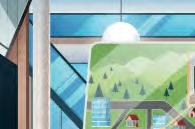
Alex Ha ha! It’s this building. Welcome to City Hall! I’m Alex. I’m going to help you do your projects for the Great Places Festival.
Learning path
Picture
Presentation: Activity 1 and 2
Workbook: Practice Ending the lesson Wonder Helper Practice: Activity 3 and 4 Starting the lesson

32
page 4
Lesson 1 – Vocabulary Student’s Book
building 2 street 3 hills apartment 5 city center 6 City Hall 7 fields 8 village 9 bridge 10 farm Places explore. and say. write. the country? the city center? the park? friends and family live? like about where you live?
t Big
t
t t t t t
t
Objectives

• Lesson aim: to ask and answer about what people like doing

• Target language: What do you/does he/she like doing? I like/He/She likes (talking to people).

• Recycled language: Places

GSE
































• Productive: Speaking: Can take part in a very simple conversation on a familiar topic if the other speaker speaks slowly and clearly.
• Receptive: Listening: Can understand simple expressions about likes and dislikes in short, simple stories or dialogs, if spoken slowly and clearly.
Wonder: sparking curiosity
• Engage students with the unit theme by having them look at the Big Picture and say where the characters live.
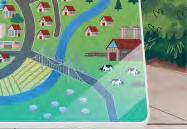
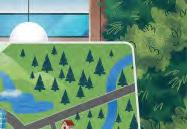
• Write the learning objective on the board: We’re learning to talk about what we like doing.

Materials



• Audio
Starting the lesson Diagnose
● To review unit vocabulary, ask students to write as many words as they can remember from the previous lesson.
1 0.05 Read. Then listen and match.
● Have students read the sentences and guess the answers. Then play the audio for students to complete the activity.
ANSWER KEY: a Sam, b Nadia, c Leo, d Bella


2 Read and learn.
● Read the Grammar box as a class. Explain that when we talk about what we like doing, we use the -ing form of the verb after like







































3 Read and circle.
● Have students complete the activity, then check answers as a class.
ANSWER KEY: 1 do, 2 meeting, 3 does, 4 likes
4 What do the characters like doing? Ask and answer.
● Do the activity as a class.
5 Ask and answer.
● Ask students to think about where they live and what they like doing there.
● Place students in pairs and have them ask and answer.

Ending the lesson
● In small groups, students ask each other what they like doing.
Assess

ACHIEVE The student can ask and answer questions about where they live and what they like doing.
ADJUST The student can understand questions about where they live and what they like doing and give an answer, but with errors.
EXCEED The student can ask and answer questions about where they live and what they like doing without prompting.
Workbook page 2
2 Read and write. Then write for you. Students refer to their Student’s Book to complete the sentences about the main characters.
ANSWER KEY: 2 What does, He likes learning, 3 What does, like, She likes helping, 4 What does, like doing, She likes showing

Activity 1
Sam Leo, what do you like doing in your village?
Audio script





Leo I like talking to people. I know a lot of people in the village. Do you like living in the city, Sam?
Sam Yes, I do. I really like learning about the different cultures in the city. There are a lot of different clothes, food, and music. It’s really cool. What do you like doing in the city, Bella?
Bella I like helping animals in the city. Not many people know about all the wildlife in the city. Do you like animals, Nadia?
Nadia Of course I do. I live on a farm! I really like telling people about the farm and showing them the country. A lot of people visit the city and they don’t come to the country.
Sam What about Alex? What does he like doing at City Hall?
Bella I think he likes helping people.
33 F02_RS_SB5_AmE_99133_Welcome.indd 5 Lesson 2 – Structures Student’s Book page 5
What does he/she like doing? He/she likes (talking to people). where I live. do / does you like doing? meet / meeting my friends. do / does she like doing? like / likes visiting new places. doing? Ask and answer. t t t t t t t Learning path Presentation: Activity 1 and 2 Practice: Activity 3 and 4 I can shine: Activity 5 Workbook: Practice Starting the lesson Ending the lesson
I can shine!
Wonder
Objectives
• Lesson aim: to read and understand a conversation about projects for a festival
• Target language: reading year dates (e.g., 2005, 1910, 2020)
• Recycled language: I want… , I love… , I like
GSE



















• Receptive: Reading: Can understand a simple written dialog on a familiar topic.
• Receptive: Listening: Can identify key information such as dates in a short description, if supported by prompts or questions.
• Productive: Speaking: Can express years using a standard format.
Imagine: fostering imagination:
• Tell students this is an “Imagine” lesson. Encourage students to be imaginative and creative in story lessons.
• Write the learning objective on the board: We can understand a conversation about projects for a festival.


Materials




• Audio
Starting the lesson Diagnose
● Ask students to say today’s date. Write it on the board. Then write the year, e.g., 2022. Ask students how we say this in English (twenty twenty-two).


1 0.06 Listen and point. Then listen again and say.
● Have students look at the dates and the pictures.
● Play the audio for students to listen and point. Then repeat for students to say the years.
2 0.07 Listen and write the dates.
● Point out that there are different ways of saying dates. The numbers are almost always said in pairs “Nineteen nineteen,” apart from the ones in the first decade (e.g., “seventeen oh three”) and 2000 to 2009.
● Play the audio for students to complete the activity.
ANSWER KEY: 1905, 1910, 2000, 2005, 2016, 2020

3 0.08 Read and listen. What do the children have to do for the Great Places Festival?
● Play the audio for students to read along and answer the question.
ANSWER KEY: They have to do six projects.
4 Read again. Then answer.
● Have students quietly read the conversation again and answer the questions. Check answers as a class.
ANSWER KEY: 1 There are six. 2 The project about being kind. 3 They can show their finished projects to everyone.
IMAGINE HELPER
Introduce students to Sam, the Imagine helper. Read Sam’s question together. Have students discuss their ideas in groups.
Narrator: Places Festival. Alex: about the projects for the Great Places Festival? Bella: What are the projects about? Alex: Come and see. Narrator: Alex tells the children about the six projects. When they complete each project, they can have a missing puzzle piece. Nadia: I love wildlife and traveling to places. Those projects sound fun. Leo: I want to do the project about being kind.
Sam: show them to everyone at the Great Places Festival.
Alex: Yes, that’s a great idea.
F02_RS_SB5_AmE_99133_Welcome.indd 6



















































5 Imagine you are at City Hall. Role-play.

2020
again and say. you want to do? children have to do for the Great Places Festival?
Places Festival? Dates
Role-play.
● Place students in groups of six and ask them to take on a role of one of the children in the conversation or the narrator.

● Give students some time to practice the play. Then invite groups to role-play in front of the class. I
Assess
ACHIEVE The student can understand information in a conversation.
ADJUST The student can understand information in a conversation with extra support.
EXCEED The student can understand information in a conversation and recount some key ideas.
Ending the lesson
ANSWER KEY: 1940, 2007, 2021, 1903, 2025, 2017 1 1903, 2 1940, 3 2007, 4 2017, 5 2021, 6 2025
Extra time: Students say three dates for a partner to write.

34
Lesson 3 – Story Student’s Book page 6
Learning path t Presentation: Activity 1 t Practice: Activity 2 t t t t t t
Practice
can shine: Activity 5 Ending the lesson Imagine Helper Story: Activity 3 and 4 Starting the lesson t
Workbook:
I
can shine!
● Ask students to write five different years for their partner to say. Workbook page 2 3 0.09 Listen and write the dates. Then number. Students listen and write the dates, then order them.
Imagine
Objectives
• Lesson aim: to understand and say the time
• Target language: What time do you wake up? I wake up at (five after seven).
• Recycled language: What time is it? (one)-thirty, o’clock


































GSE
















• Productive: Speaking: Can tell the time of day to within ten minutes. Can ask simple questions about times and events.
Build: building confidence
• Tell students this is a “Build” lesson. Review the use of (one)-thirty and o’clock
• Write the learning objective on the board: We’re learning to say the time.
Materials










• Audio

I can shine!
Starting the lesson Diagnose
● On the board, write I like… . Ask different students to complete the sentence. Then ask what time of the day they usually do these things.






1 0.10 Listen and number.
● Have students look at each clock and its caption. Say the time and ask them to repeat it.

● Play the audio for students to number them 1–8.
ANSWER KEY: 1 f, 2 c, 3 e, 4 b, 5 d, 6 a, 7 h, 8 g
2 Ask and answer.
● Model the activity with a confident student.
● In pairs, students complete the activity.
3 0.11 Read and learn. Then listen and write.
● Read the Grammar builder box as a class.



BUILD HELPER
Have students look at Nadia, the Build helper. Explain that they will listen to the children and Alex talking about what time they do activities. Play the audio for students to complete the activity.

ANSWER KEY: 1 nine o’clock, 2 ten-thirty, 3 quarter to eleven, 4 ten after twelve, 5 twenty to one, 6 quarter after two




















4 Ask and answer.
● In pairs, students ask and answer about what times they do the activities.
Assess
ACHIEVE The student can ask and answer about the times of activities.
ADJUST The student can ask and answer simple questions about the times of their activities using prompts.
EXCEED The student can ask and answer simple questions about the times of their activities and the routines of others.
Workbook page 3
4 0.12 Listen and complete for Linda. Then complete for you and write.
ANSWER KEY: Linda: has lunch at 12:30, goes to bed at 20:15 2 She has lunch at twelve-thirty. 3 She goes to bed at quarter after eight.
Activity 1
1 What time is it, please?
It’s twenty to three.
2 What time does your brother go to sleep?
He goes to sleep at six o’clock.
3 Excuse me, what time is it? It’s nine-thirty.
4 What time do you wake up? I wake up at twenty after ten.
Activity 3
Audio script
5 What time is it? It’s ten after one.
6 What time is it? It’s ten to seven.
7 Excuse me, what time is it? It’s quarter to five.
8 What time do you have lunch? I have lunch at quarter after twelve.
Alex OK! Here’s the schedule for today. We start work on our projects at nine o’clock. We can have a break at ten-thirty.
Sam Can we go to the cafe?
Alex Yes, you can. But don’t come back late! We’re going to watch a video at quarter to eleven. Lunch is at ten after twelve. I’m going to order some food and we can eat it here in the City Hall. Let’s finish lunch at twenty to one. Is that OK? We go home at quarter after two. Are there any questions?
Bella Yes, I have a question.
Alex Yes, Bella?
Bella Um… What’s for lunch?
35 F02_RS_SB5_AmE_99133_Welcome.indd 7 What time do you wake up? I wake up at (five after seven). It’s nine-thirty. It’s twenty after ten. It’s twenty to three. It’s six o’clock. It’s quarter after twelve. It’s ten after one. It’s quarter to five. at quarter to six. wake up? I wake up is it? does he What time
Lesson 4 - Communication Student’s Book page 7
t t t t t t t t t Learning path Presentation: Activity 1 Practice: Activity 2 Presentation: Activity 3 Build HelperI can shine: Activity 4 Workbook: Practice Starting the lesson Ending the lesson
Build
Objectives
• Lesson aim: to read about how people are solving everyday problems in different countries
• Speaking function: to express ability
• Global citizenship theme: Working together where we live

• New language: Argentina, China, Italy, Mexico, Poland, Spain, Turkey, U.K., U.S.A.
• Recycled language: I can… , We can…
GSE
• Productive: Speaking: Can talk about a familiar place in a basic way.
• Receptive: Reading: Can understand the main ideas in simple informational texts, if supported by pictures.
Grow: nurturing growth in society




• Tell students this is a “Grow” lesson. Promote global citizenship by increasing students’ awareness of diversity in countries around the world.
• Write the learning objective on the board: We’re reading about different countries. Materials
• Audio; a world map
Starting the lesson Diagnose
● Tell students to think about where they live. Ask them to say what things they can and can’t do there.
1 Look quickly at the text. What is it? Circle.





















































● Tell students to look at the text. Ask them what type of text it is and how they know.
ANSWER KEY: c – a website
2 0.13 Read and listen. Which countries do you think the pictures show?
● Ask students to look at the pictures and say which countries from the box they think they show.
● Play the audio for students to listen and read along.
ANSWER KEY: a China, b U.K., c Mexico
3 Read again. Then answer.
● Give students a few minutes to read the text again.
● Place students in pairs to answer the questions.
ANSWER KEY: 1 They plant trees. 2 They help people with their shopping in grocery stores. 3 new skills, like how to play board games, 4 Turkey
GROW HELPER
Introduce students to Alex, the Grow helper. As a class, elicit ideas about how people help each other where they live.
4 Talk with a friend. How can you make your area a great place to live?

● Ask students to think about the three topics and how they can make their own area better.
● Have students share their ideas in pairs. Encourage students to use We can… to structure their answers.
I can shine!
Assess
ACHIEVE The student can express ability with a little prompting.
ADJUST The student can express ability, but with errors.
EXCEED The student can express ability fluently and without prompting.
Ending the lesson
● Play a questions game. Have students sit in small groups. Ask one student a question, e.g., What time do you go to school? and elicit the answer. Then that student asks the person on his/her right the same question. Then ask a different student another question, e.g., What do you like doing where you live? Elicit the answer. Students continue in the same way and can ask their own questions.
Workbook page 3
5 Find and circle nine countries. Then do the Countries Quiz. Students do the wordsearch, then answer the questions.
ANSWER KEY: 2 China, 3 Italy, Argentina, and Mexico, 4 U.K., 5 U.S.A., 6 Turkey, 7 Poland
36 Globa Citizen Globa Citizen Global Citizen Global C tizen Globa C tizen Globa Citizen OptA F02_RS_SB5_AmE_99133_Welcome.indd 8 can you make your area a great place to live? Working together to improve where we live. do you think the pictures show? the streets are safe and quiet. also good for the environment. songs, and music. from plants. There’s less plastic trash in towns and the country. The streets are other where you live? where we live.
Lesson 5 – Global citizenship Student’s Book page 8
Learning path t t Presentation: Activity 1 and 2 t t t t t Workbook: Practice I can shine: Activity 4 Ending the lesson Grow Helper Practice: Activity 3 Starting the lesson t Grow
Objectives
• Lesson aim: to review language from the unit and make a progress puzzle
• Reviewed language: city, farm, City Hall, buildings, quarter to, What time is it? I like…
































GSE















• Productive: Writing: Can write simple sentences to describe pictures.



















• Productive: Speaking: Can describe a picture showing a familiar scene or activity using simple language, if prompted by questions.

Shine: Time to shine!

• Encourage students to develop learner autonomy by having them think about what they know and what they lack confidence in.
• Write the learning objective on the board: We’re reviewing what we’ve learned in the unit and making a progress puzzle.
Materials













• Coloring pencils, scissors
Starting the lesson Diagnose
● Ask students to say as many new words that they have learned in this unit as possible. Write them on the board.
Review

















1 Look and write.
● Have students complete the activity and compare answers with a partner.
2 Ask and answer about the times in the picture.
● Review telling the time as a class.
● Place students in pairs to complete the activity.
3 Look at the pictures and practice saying the dates on the buildings.
● Review the dates as a class.
● Place students in pairs to complete the activity.
Create
4 Create your progress puzzle. Write a topic on each puzzle piece.

● Have students look at the example in the Student’s Book. Tell students that the pictures on each puzzle piece should reflect each of the unit topics.
● Explain to students that they will refer to this puzzle at the end of each Review unit.
● Have students make their own puzzles individually.
5 Ask and answer.




● Students ask and answer questions about their pictures and the different projects in pairs.
Time to shine!
6 Present your picture to the class.
● Tell students to write a few sentences about their picture before presenting their work to the class.
Ending the lesson
● Ask students to look back through the unit and to find something they would like to do again. Have a class vote and do the most popular activity again.
● Refer students to the Progress Chart on page 3 of the Student’s Book. Have them read the sentences for each skill and notice what they have achieved so far.
Workbook page 3
I can shine!
6 Write about you. Students complete the activity about themselves.
Extra time: Students see how many new words they can make from the phrase. You can give them a time limit or ask them to compare with a partner afterwards. Then see who has found the most words.
Time to shine!
Assess
ACHIEVE The student can use simple sentences to talk about where they live and what they like doing there. They can say a range of times in English.
ADJUST The student can say where they live and describe what they like doing in one or two simple sentences. They need support with telling the time.
EXCEED The student can talk about where they live and what they like doing there confidently with little or no support. They can say any time in English and use it to describe when they do activities.
37 F02_RS_SB5_AmE_99133_Welcome.indd 9 to the class. Write a topic on each puzzle piece. times in the picture. saying the dates on the buildings. with fields… . It’s the morning.
Lesson 6 – Review and project Student’s Book page 9 t t t t t t t Learning path Review: Activity 1, 2, and 3 Project: Activity 4 and 5 I can shine: Activity 6 Workbook: Practice Starting the lesson Ending the lesson Shine











































































































 Bella Leo Nadia Sam
Bella Leo Nadia Sam











































































































































































































































































































































































































































































